This 22-day cycling tour takes you from Kunming in China to Luang Prabang and Vientane in Laos where you’ll discover a world of dramatic rock formations melding into tropical forests, traditional farming villages and ethnic minority communities, on both sides of the border. Most days feature afternoons out of the saddle to rest and explore on ground level with a variety of Buddhist temples and local markets adding to opportunities to check out the regional cuisine and compare how one town or village compares to the next. Roads are mainly well paved with some mountainous terrain inviting long climbs although luggage transfers, support cars and knowledgeable guides ensure that every effort has been made to increase enjoyment levels on this fair to moderate cycling tour.
Highlights:
- Cycle from China to Laos, with charming scenery along the way.
- Have grand view of Yunnan and learn more about culture of Laos.
Breif Itinerary:
- Day 1 Arrive in Kunming
- Day 2 Kunming-Eshan
- Day 3 Yuxi (玉溪) – Huanian (化念)
- Day 4 Huanian (化念) – Ganzhuang (甘庄)
- Day 5 Ganzhuang (甘庄) – Mojiang (墨江)
- Day 6 Mojiang (墨江) – Tongguan (通关)
- Day 7 Tongguan (通关)– Ning’er (宁洱)
- Day 8 Ning’er (宁洱) – Pu’er (普洱)
- Day 9 Pu’er (普洱) – Dadugang (大渡岗)
- Day 10 Dadugang (大渡岗) – Jinghong (景洪)
- Day 11 Jinghong (景洪) – Menglun (勐仑)
- Day 12 Menglun (勐仑) – Mengla (勐腊)
- Day 13 Mengla (勐腊) – Na Teuy, Laos
- Day 14 Na Teuy – Oudomxay
- Day 15 Oudomxay – Pak Mong
- Day 16 Pak Mong – Luang Prabang
- Day 17 Luang Prabang
- Day 18 Luang Prabang-Kasi
- Day 19 Kasi-Vang Vieng
- Day 20 Vang Vieng-Thalat
- Day 21 Thalat – Vientiane
- Day 22 Departure from Vientiane
Google Map
Detailed Itinerary
Day 1 Arrive in Kunming
Sightseeing and Activities: Arrive in Kunming
Accommodation: Kunming
Meals: Lunch
Upon your arrival, your guide will meet you at arrival hall in the airport. Transfer to your hotel to check in and relax. In the afternoon, meet your tour guide to have a try of your bike.
After that, you will enjoy your free time to explore the city.
Day 2 Kunming-Eshan
Sightseeing and Activities: Kunming-Eshan
Accommodation: Eshan
Meals: Breakfast, Lunch, Dinner
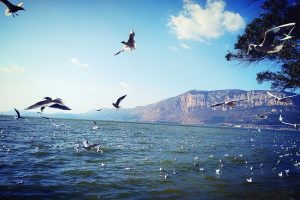
After all the introductions and formalities to introduce our event “Cycling Southeast Asia, 2011: Messengers of Friendship,” we set off from Kunming, crossing the bridge over Dianchi Lake towards Xishan. From there we had a wonderful ride paralleling the highway all the way to Haikou. It was especially sweet for me as the roads were the best I’ve seen over our first seven days as was the weather, and Chris Horton from GoKunming let me ride in his slipstream the whole way!
After lunch, our friends left us to face the dusty roads ahead and eventually the rain too. From Haikou to Yuxi it’s about 60km, and for about 10km at the base of Dianchi the road turns to dust, and is very slow going. Shortly after the road gets better, you pass the famous Chinese explorer Zheng He‘s hometown of Jinning. A short incline at about kilometer 65 for the day, and then a nice long descent, being careful to avoid the truck traffic.
Unfortunately, the end of our ride was met with some heavy rain, but it was all worth it in the end, as just two kilometers west of Yuxi there is a natural hot springs and every room in our hotel was decked out with its own personal outdoor hot (spring) tub!
Day 3 Yuxi (玉溪) – Huanian (化念) – 78km, 5 hours of riding
Sightseeing and Activities:Yuxi (玉溪) – Huanian (化念) – 78km, 5 hours of riding
Accommodation: Eshan
Meals: Breakfast, Lunch, Dinner
We were all thawed out from the previous day’s rain and mostly dry. It was looking like the weather was going to clear up, but sure enough, as soon as we started out it began to rain, and it continued all day.
There is a mild climb coming out of Yuxi, and the road is being rebuilt. For about 10km the mud was so bad that even motorcycles couldn’t get through. Luckily most of the worst parts are on a long descent about 15km into the ride, and if you’re brave enough you can ride most of it.
I’m not sure how smart it was, but I rode/slid down most of it and my bike was caked with mud. We had a nice lunch in Eshan (峨山) at the base of the mountain and stopped at a car wash to hose down our bikes.
From Eshan it’s about 35-40km of great cycling, winding through the mountains with lots of small hills to zoom up and down. We finished our ride with an 18km descent to the town of Huanian, tucked in a valley of white plastic farmland. We arrived late and found no open restaurants, so had to settle for some instant noodles in our cold hotel room, quite a change from the night before!
Day 4 Huanian (化念) – Ganzhuang (甘庄) – 69km, 5 hours of riding
Sightseeing and Activities:Huanian (化念) – Ganzhuang (甘庄) – 69km, 5 hours of riding
Accommodation: Yuanjiang
Meals: Breakfast, Lunch, Dinner
Another cold, rainy day… beginning to reconsider biking in Yunnan in January, but I still think it’s worth it as it’s only tough riding when it rains, and I think rain three days in a row is pretty rare here. Great roads all day today, with some big climbs, but even bigger descents.
The scenery in Southern Yunnan is breathtaking and you can really begin to realize its incredible productivity. On the way today we passed several factories, including one massive steel plant, and endless amounts of healthy farmland planted with just about anything you can imagine. We had a few technical difficulties today including two flat tires and some minor adjustments on brakes and derailleurs which slowed us down quite a bit. Around dusk we descended into the pleasant town of Ganzhuang.
Day 5 Ganzhuang (甘庄) – Mojiang (墨江) – 99km, 7+ hours of riding
Sightseeing and Activities: Ganzhuang (甘庄) – Mojiang (墨江) – 99km, 7+ hours of riding
Accommodation: Puer
Meals: Breakfast, Lunch, Dinner
In retrospect, we should have done more miles the day before to cut off some today. The day started with an 8km warm-up climb. A short, fun, but somewhat unsatisfying descent followed and led us into a massive climb at about the 13km mark. From here we began to slowly climb for what seemed to be most of the day.
About 10km up there is a hot spring, and if you climb down to it you can have lunch while soaking your feet in the 43 degree (105 degrees Fahrenheit) water. Lunch was basic: eggs boiled in the hot spring – not in the same water we were soaking our feet in – and cold rice noodles. After lunch we continued to climb the rest of the 35km hill, gaining 1,600 meters in elevation. A series of smaller hills followed, the last being an excruciating 7km climb until our final descent into Mojiang.
Day 6 Mojiang (墨江) – Tongguan (通关) – 74km, 6 hours of riding
Sightseeing and Activities: Mojiang (墨江) – Tongguan (通关) – 74km, 6 hours of riding
Accommodation: Puer
Meals: Breakfast, Lunch, Dinner
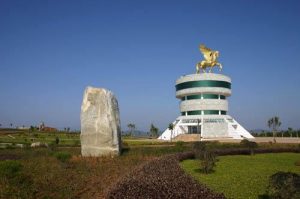
After reluctantly accepting some gifts of rice wine, we hopped back on Old Road 213. The morning was filled with some great cycling, we whipped through the countryside. A great 15km descent down to a large river ended our morning and we had a delicious lunch just on the other side of the bridge. Some of the specialties were wild bitter fruit (山苦果) and some wild olives that mildly resembled the taste of olives.
After lunch, we followed the river upstream for about 25km, soaking up the beautiful view of the fertile valley. Towards the end of the day we began climbing slowly back up to the expressway and over a mountain. Some amazing views of the sunset and then a couple of kilometers’ descent into the new town of Tongguan.
The hotel was nice, but there wasn’t much in the town except for a “park” on top of a nearby hill with a golden Pegasus on top. There is a poorly built museum there too, showing off some artifacts of the Old Tea and Horse Road. If possible I would look for lodging in the old town of Tongguan just before you get to the new town. It seemed a lot more lively.
Day 7 Tongguan (通关)– Ning’er (宁洱) – 89km, 6 hours of riding
Sightseeing and Activities:Tongguan (通关)– Ning’er (宁洱) – 89km, 6 hours of riding
Accommodation: Puer
Meals: Breakfast, Lunch, Dinner
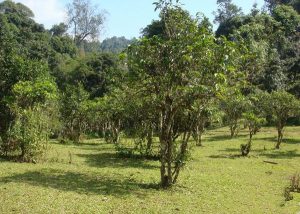
A late night of drinking with the mayor of Tongguan and a long morning of him showing us around and giving us bricks of tea (…great, more weight to carry) meant a late start, but we still managed to do almost 90km. In between the old and new town of Tongguan, we bore right down the hill and cruised the 17km descent to the river. From there the road flattens out and follows the river for quite some time. The road is great for cycling here and the views of the river bank and coffee plants are breathtaking.
At about kilometer 70, we took a right towards Ning’er and joined all the traffic of the expressway, as it was still under construction. It was about a 12km climb in heavy traffic with no shoulder, and then a shorter descent into Ning’er. A different route would be recommended if the expressway is still under construction here.
Day 8 Ning’er (宁洱) – Pu’er (普洱) – 47km, 3.5 hours of riding
Sightseeing and Activities:Ning’er (宁洱) – Pu’er (普洱) – 47km, 3.5 hours of riding
Accommodation: Puer
Meals: Breakfast, Lunch, Dinner
A nice short day, but still not one to joke about. Again, we were riding in heavy traffic, and with the rain it was quite miserable. Pu’er sits considerably higher than Ning’er and we most definitely felt it. Climb after climb with very short descents. I was surprised by the integration of the coffee and tea plants everywhere and wondered about the benefits; a peaceful sign, maybe, of bringing our differences together.
Day 9 Pu’er (普洱) – Dadugang (大渡岗) – 78km, 5 hours of riding
Sightseeing and Activities:Pu’er (普洱) – Dadugang (大渡岗) – 78km, 5 hours of riding
Accommodation: Xishuangbanna
Meals: Breakfast, Lunch, Dinner
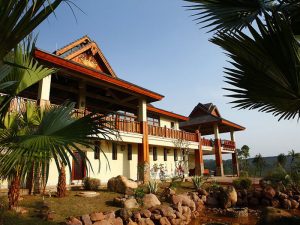
We spent a wonderful night in Pu’er as guests of Fudian Bank which was followed by wonderful weather all day.
Unfortunately, one of our team members, Jin Feibiao (Feibao’s older brother) fell on a descent early this morning before the road had a chance to dry. He rode another 20km to lunch, where he took a van to Jinghong to see a doctor. The diagnosis was a broken collarbone, and he flew back to Kunming for further treatment. He will be certainly missed on our trip.
Out of Pu’er we hopped back on Old Road 213 (a left turn at the southwestern end of the city). The road climbs for the first 5km and then descends quickly for about 8-9km more. A section is under construction at the 22km point making the short climb quite difficult. The rest of the day sees only small hills until the 68km mark where it begins to climb all the way to Dadugang at the top of the hill – be sure to stay right at the fork at about 76km to continue up and not down to the expressway. Dadugang only has two hotels and the one down the hill is basic, but with hot water and all rooms are on the first floor.
Day 10 Dadugang (大渡岗) – Jinghong (景洪) – 83km, 5 hours of riding
Sightseeing and Activities:Dadugang (大渡岗) – Jinghong (景洪) – 83km, 5 hours of riding
Accommodation: Xishuangbanna
Meals: Breakfast, Lunch, Dinner
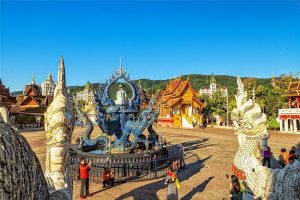
It was a bit cold on top of the mountain this morning, but after a great breakfast feast of rice noodles, youtiao and bean soup, little baozi, and dumplings we headed out into the fog.
The first 10 km was a wonderful warmup, we were shooting up and down atop the ridge. If it hadn’t been so foggy, I’m sure it would have offered beautiful views of the surrounding tea country. After the warm up, there is a fast 11km descent back to the expressway and into the Xishuangbanna Nature Reserve. From there the old road continues to decline, winding around the hills as the expressway cuts right through them. At kilometer 47 for the day the road flattened out and a few kilometers later we had lunch at Xiaomengyang (小勐养).
Just before the town there is an intersection with the expressway. The first left is the expressway and the immediate second left heads towards Mengla. If you take the second left it is only 23km to Jinghong on all new roads. We were told the old road was much longer and a lot harder to bike. The new road was indeed nice, but you had to first climb a steep 6km hill before the long fast descent into Jinghong.
At the first traffic circle take a left and follow it to go over the bridge and soak in the views of the Mekong and the city. We took ten days getting here, including one day’s rest in Mojiang. With our group size and heavy loads, I would say we did pretty good.
If you were just two people with light loads it could easily been done in a week’s time, but don’t forget to take some time to absorb the beautiful sights of southern Yunnan. From here we will head south to Mengla and across the border into Laos where we plan to take a month cycling from the north to the southern tip.
Day 11 Jinghong (景洪) – Menglun (勐仑) 65km, nearly 3 hours of riding
Sightseeing and Activities:Jinghong (景洪) – Menglun (勐仑) 65km, nearly 3 hours of riding
Accommodation: Xishuangbanna
Meals: Breakfast, Lunch, Dinner
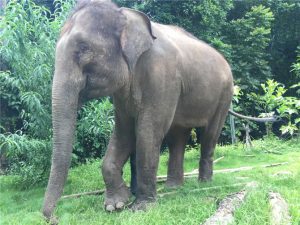
Jinghong was a wonderful place to rest for two days. Aside from the amazing food, the incredibly friendly people and the beautiful weather, it was just nice to rest the legs (and the butt!) after battling Yunnan’s mountains for over a week. Jinghong also sits in a very strategic location. As the capital of Xishuangbanna, it also has very easy access to Southeast Asia. Before departing, our team received some more letters from the governor of Xishuangbanna to be delivered to Southeast Asia as well as the ones we are already carrying from the Kunming mayor.
From Jinghong we backtracked our route a bit, crossing back over the Mekong (or Lancang River 澜沧江) in the northeastern part of the city and up the mountain we had descended just a few days earlier. Make sure you exit the expressway in the beginning following signs to the National Forest and not towards Wild Elephant Valley.
With fresh legs, we zipped right up the 13km mountain. At the top of the hill, the road splits: left is back to Kunming and right heads toward Mohan and Laos. After you take the right the road turns into an expressway, but there is little traffic, a wide shoulder, and a much quicker shot to Laos then any of the other alternatives. From here the road evens out for two or three kilometers, then it drops slowly for about 25km to where we had lunch.
The views were incredible, with vast mountain ranges covered with tea trees and eventually nothing but rubber trees. There were a few short tunnels on the descent, which was much better than having to go around the mountains, so be prepared with lights, especially in the back. After lunch it was a straight shot to Menglun only 23km more.
Among the huge rubber tree plantations in Menglun lies the largest botanical garden in China, worth a visit just on its own. It also doubles as an internationally accredited science academy. We stayed in a hotel inside the park, but there are plenty of options outside it as well.
Day 12 Menglun (勐仑) – Mengla (勐腊) 80km, 4.5 hours of riding
Sightseeing and Activities:Menglun (勐仑) – Mengla (勐腊) 80km, 4.5 hours of riding
Accommodation: Xishuangbanna
Meals: Breakfast, Lunch, Dinner
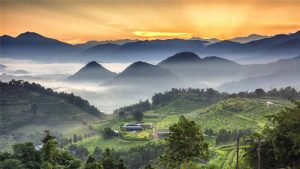
From Menglun we hopped back on the expressway, called Erji Lu (二级路), which soars above the valleys and cuts right through the mountains. Be sure to have all your lights handy again, as we passed though about 15 tunnels today, two of which were over 3km long.
Outside of Menglun there is a slow, steady 20km climb which ends with a 3km tunnel and then descends back down about 12km. About one kilometer after the toll booth at the bottom of the climb is Mengyuan (勐远), a good resting point with plenty of options for food and drink. After lunch, the road began to rise again steadily, passing through numerous tunnels until the final 10km where it descended into Mengla (a right hand turn, 1km off the expressway).
Mengla is a big town with many options for sleeping and eating. On top of this it is only 46km from the Laos border. If you’re up for it, there is a wonderful park about 18km away (we took a bus) called Sky Tree Tropical Rainforest Park (望天树热带雨林公园), which has the world’s highest canopy walk of 38 meters and plenty of entertainment and wilderness to keep you busy a few days.
Day 13 Mengla (勐腊) – Na Teuy, Laos – 67km, nearly 4 hours of riding
Sightseeing and Activities:Mengla (勐腊) – Na Teuy, Laos – 67km, nearly 4 hours of riding
Accommodation: Laos
Meals: Breakfast, Lunch, Dinner
It is only 46km from Mengla to the border town, Mohan, on the expressway. It is a bit hilly but the road is great and you barely notice the hills. It’s a good idea to leave some time for the border crossing, but we had no trouble at all. It cost me 300 yuan to get my visa on arrival. The next town in Laos is Boten, only 3km from the border.
We decided to continue on as border towns are infamous for crime, and this one didn’t seem to be any different. A little less than 20km down the road lies the intersection of the roads leading to Luang Namtha (right) and Oudomxay (straight) in the town of Na Teuy. There are two basic guesthouses here, and a few restaurants, both Lao and Chinese styles.
Day 14 Na Teuy – Oudomxay – 82km, 5 hours of riding
Sightseeing and Activities:Na Teuy – Oudomxay – 82km, 5 hours of riding
Accommodation: Oudomxay
Meals: Breakfast, Lunch, Dinner
After a wonderful breakfast of Lao-style rice noodles, we set off for Oudomxay, the biggest city in northern Laos. The road which was great all the way from Jinghong, turned to dust only a few kilometers after Na Thuai. The road is being rebuilt by the Chinese all the way to Oudomxay, but there are some nice sections still that they hadn’t torn up. At the 28km mark for the day we had lunch in the small town of Meng Namo.
After lunch we continued on and the road begins to rise. Altogether it rises about 500m over a 25km stretch. It is a slow climb with frequent resting points, brief downhills and tons of marvelous little villages were everyone shouts “Sabaidee!!” The children were especially happy to see us, as we handed out candy along the way.
During our climb we could begin to hear music coming from the top of the mountain. Needless to say at the very top there was a small village throwing a party. We stopped and joined the festivities briefly, but continued on as to not impose too much. From here there is a nice and long descent into Oudomxay. Unfortunately, the descent is filled with patches of gravel, or just dust, so we had to take it really slow.
Day 15 Oudomxay – Pak Mong – 84km, 5.5 hours of riding
Sightseeing and Activities:Oudomxay – Pak Mong – 84km, 5.5 hours of riding
Accommodation: Pak Mong
Meals: Breakfast, Lunch, Dinner
Another day filled with the gorgeous mountains of northern Laos. Leaving Oudomxay follow the main road to the right, then after 5km turn left towards Luang Prabang. From here the road climbs about 14km. At the 11km mark there is a nice waterfall and a small shop for a snack or drink. After the first climb there is a short descent and then another climb lasting about 9km.
From here the road descends to the town of Lak 32 (“Kilometer 32”). There is a nice market here to buy some fruits, as well as one small restaurant and several rice noodle stands.
From here there is not much else besides small mountain villages all the way to Pak Mong. It’s best to fuel up in Lak 32, as soon after you begin a long climb lasting a total of 22km. We stopped at a spring about half way up and then again at the small village at the top to shoot some pool with the locals while we waited for the rest of the team to catch up.
It became dark fast and we regretted our late start as the 20km of distance/900m of elevation descent into Pak Mong was quite difficult as the road was the same as it was all day – smooth riding one minute, then spoke breaking the next!
Day 16 Pak Mong – Luang Prabang – 110km, 9 hours of riding
Sightseeing and Activities: Pak Mong – Luang Prabang – 110km, 9 hours of riding
Accommodation: Luang Prabang
Meals: Breakfast, Lunch, Dinner
Pak Mong is a noisy intersection filled with truck and bus traffic. Needless to say everything closes late and opens early. We were staying in probably the nicest place, run by a Chinese family, and still it was nothing to brag about. I was happy with clean sheets, though.
From Pak Mong to Luang Prabang the road is relatively flat, and not one pothole in sight. Unfortunately, the mayor of Luang Prabang had scheduled to meet us that afternoon, so we had no choice but to pile our bikes into a tuk-tuk and skip probably one of the nicer of our rides. From the back of the tuk-tuk, the scenery was still quite spectacular though.
Day 17 Luang Prabang
Sightseeing and Activities: Luang Prabang
Accommodation: Luang Prabang
Meals: Breakfast, Lunch, Dinner
After breakfast, we will fit you for your bike then enjoy a tour around Luang Prabang with the Mekong river as our backdrop. You will soon understand why it deserves the World Heritage title! Visit Wat Visoun, the site of impressive Thad Makmo stupa. The rounded dome is stylistically more Sinhalese than Lao. Wat Xieng Thong further emphasizes & characterizes the uniqueness of Luang Prabang, its several roofs sweeping low to the ground. See also the impressive “tree of life” mosaic here. The gilt panel on the exterior of the chapel depicts episodes from the Ramayana. Then visit the National Museum (closed on Tuesday), once a king’s palace, where displayed inside is a lovely collection of personal artifacts of the royal family, including photos, musical instruments, and many gifts received from the dignitaries of foreign countries. Wat Mai was built in 1796, the five-tiered roof of the wooden Sim (chapel) epitomizes the graceful Luang Prabang architectural style. This afternoon, you continue settle in that will take you to the secrets of the town’s wetlands, centuries old temples, a Saa Paper village before going back to the town, you will visit a weaving centre, where you get an explanation of the silk weaving process. Look at silkworm, natural dyes and meet the weavers. Then climb Phousi Hill to enjoy the view overlooking the city and watch the amazing sunset. From here you can see the magic Mekong and the small Nam Khan rivers. This evening you have to yourselves. Maybe explore the local restaurants or indulge in another massage, the choice is yours. Overnight in Luang Prabang
Day 18 Luang Prabang-Kasi
Sightseeing and Activities: Luang Prabang-Kasi
Accommodation: Kasi
Meals: Breakfast, Lunch, Dinner
Today we cycle south of Luang Prabang and up into the mountains through incredible scenery, using our support vehicle to break up the journey on the uphill sections. After breakfast, we’ll cycle 30 km to Xieng Ngeun, with part of our route running along the Nam Khan River, before cycling around 30km towards Ban Pongdong. Here we will rejoin our bus, driving through lush mountain scenery to Ban Thong Meuad. We’ll then hop back on our bikes and enjoy a thrilling descent for another 25km to the town of Kasi, set in a lush valley along the Nam Lik River. Cycling distance: 85 km (mostly flat / downhill) Overnight in Kasi.
Day 19 Kasi-Vang Vieng
Sightseeing and Activities: Kasi-Vang Vieng
Accommodation: Elephant crossing hotel
Meals: Breakfast, Lunch
We should be able to do today’s ride in a single morning leaving extra relaxation time in Vanvieng. We continue along route 13 and although there are some short climbs most of the ride is downhill or flat. The scenery is just beautiful and you should really enjoy stretching your legs. We will stop for refreshments a few times along the way, but we make a main stop after 50 km at a big village of Ban Phatang. The last 18 km is a fast flat ride among the spectacular limestone mountains. We will reach the hotel in time to enjoy lunch overlooking the river. The afternoon is free to explore the town or take a swim in the river. Vangvieng has a lively traveler’s scene with all the usual accompanying facilities: e-mail, pubs, pizza and many young foreigners.
Altitude: Kasi = 405 m. Vangvieng = 280 m
Ride: 58 km
Meal: B , L
Accommodation: Elephant crossing hotel.
Day 20 Vang Vieng – Thalat
Sightseeing and Activities: Vang Vieng – Thalat
Accommodation: Guesthouse of Thalat
Meals: Breakfast, Lunch, Dinner
We have a long ride today and the heat may be the factor so we will want to leave early. We continue along the route 13 and stop for refreshment every 20 or 25 km. The rest of the morning is along undulating roads to Hinherb village. After 69 km we reach a long bridge, we stop for lunch in a restaurant. The afternoon ride is along fast flat roads. After 83 km, we turn left at a main junction of Phonhong town. After 15 km of riding along the flat road and takes, us into the town of Thalat near the NamNgum dam. We stay in Napakuang resort and have dinner at our resort.
Altitude: Vangvieng = 280 m. Thalat 190 m
Ride: 100 km
Meal: B, L, D
Accommodation: guesthouse
Day 21 Thalat – Vientiane
Sightseeing and Activities: Thalat – Vientiane
Accommodation: Sengtawan hotel
Meals: Breakfast, Lunch, Dinner
We ride out of Thalat pass the NamNgum dam, we have one sharp hill in the morning then it is all fairly flat, we stop for lunch in a local restaurant when we feel like it. Riding today there are more traffic so please remember to keep riding on right side all the time and we regroup before getting into town and then we cycling to hotel. Tour Is Over
Altitude: Thalat = 190 m. Vientiane = 180 m
Ride: 93 km
Meal: B, L
Accommodation: Sengtawan hotel
Day 22 Departure from Vientiane
Sightseeing and Activities: Departure from Vientiane
Accommodation:
Meals: Breakfast
Departure from Vientiane
Recommended Hotels
| Destination | 5 Star | 4 Star | 3 Star | Hostels |
| Kunming | Sofitel Hotel | Kunming Jinjiang Hotel | Kunming Longteng Hotel | Local Hostel |
| Yuxi | Hilton Yuxi Fuxian Lake | Hongta Hotel | Lavande Hotel | Local Hostel |
| Puer | Meizi Lake Spa Hotel | Jinglan Hotel | Mingting Hotel | Local Hostel |
| Jinghong(Xishuangbanna) | InterContinental Hotel | Jinghong Dai Garden Hotel | Jinglan Business Hotel | Local Hostel |
Service Included:
- Accommodation with daily breakfast as indicated in the hotel list;
- Chinese lunches as listed in the itinerary;
- All land transfers & transportation with private air-conditioned car;
- All transfers and sightseeing with skilled English-speaking tour guide;
- All entrance fees as mentioned in the itinerary;
- All government taxes;
- Luggage transfers between hotels;
- Travel Agency’s Responsibility Insurance coverage
Service Excluded:
- Any arrival and departure international airfares or train tickets;
- Any meals which are not specified in the tour itinerary.
- Chinese visa fees;
- Excess baggage charged by Airlines;
- Single room supplement;
- Tips to guides and drivers;
- Personal expenses and gratuities to service staff.
- Personal travel accident insurance.
- All optional programs;
Travel Tips:
- Visitors are advised to always carry changes of clothing due to the large variations in temperature between day and night.
- The climate is relatively dry, so drink more water every day.
- Protecting oneself from strong UV radiation at high altitude.
- Protecting oneself from altitude sickness. Lessen the effects of altitude sickness, avoid strenuous exercise and have plenty of rest.
- Respect local customs , habits, and religious beliefs.
Mohan is located in Mengla County, Xishuangbanna Dai Autonomous Prefecture, Yunnan Province, China. It is a small border town situated in very south end of Yunnan province in China. If you are planning to go to Laos from China or vice versa, you’ll be passing through this small town, because the immigration (border control) is here.
Highlights of Mohan
Mohan Port: It is China’s only national land port to Laos and the most convenient land access to southeast Asia.
Border Culture: As a small border town, the border culture at Mohan is colorful and diverse. Recent years, there is China-Laos border cultural tourism festival.
Cycling Route of Jinghong(景洪) Xishuangbanna(西双版纳) to Laos and Thailand No.2 (Mohan(磨憨) China — Vientiane Laos)
Introduction of Area: Cycling starts with Mohan(磨憨) China, which is a bridgehead of China catering to Southeast Asia, and ends with the capital of Laos, Vientiane. You will experience the original ecological northern mountain area of Laos.
Route of Cycling: Mohan(磨憨) town in Mengla(勐腊) County of China-Boten-Udomxai- Luangphrabang-Vangvieng-Vientiane
Climate of Area: This area is rich in heat, warm all the year round and trees are evergreen. A year is only divided into two seasons, the rainy season with 5 months, (from middle or last of May to October) and the dry season with 7 months (from October to middle or late of May of following year).
Best Time of Cycling: The best cycling time of this route is in October each year to April of following year (it’s warm, foggy and less rain). In addition, there is Water-Sprinkling Festival, the traditional New Year of Laos, in every year of middle April.
Transfer station: Kunming(昆明) or Jinghong(景洪)
Length of Cycling: It takes 6 to 8 days to arrive destination at normal speed, maximum 10 days if you are in a bad comdition.
Content of Cycling: Primary forest + Original ethnic minority customs of Laos
Evaluation of Route: Whole journey: About 650 kilometers Spend Time: 6-8 days Degree of Difficulty: Medium difficulty Difficult Point: Rise exceeds 1000m. Be concerned about protecting yourself from the sunburn.
Riding levels: The highest is five stars
Labor Intensity★★★★
Technical Difficulty★★
Thrills and Spills★★★★
History and Cultural★★★
Natural Scenery★★★★★
A Suitable Number: 1-18 persons
Best Route: Mohan(磨憨)-Boten-Nabo-Udomxai-Louangphrabang-Vangvieng-Vientiane
Equipment: If you are going to camp out, bring tent, sleeping bag, moisture-proof pad, head lamp, compass, stove, matches and so on. It’s also good to go with a light pack, for there are a lot of nice lodging spots. Staying in the original ecology village is one of highlights in this cycling activity and the original ecological scenery of Vangvieng area is picturesque.
Itinerary:
Day 1: Mohan(磨憨)-Boten-Nabo-Udomxai 95KM
The whole way road is built recently. You’d better set out early this day, because it takes time to pass the customs in Mohan(磨憨) because of inspection. If you set out from Shangyong(尚勇) town of China before 8 am, the customs is just open when you arrive there. Before you pass the customs, you can exchange money first. One RMB yuan can exchange 1200-12600 Lao kip. (There are many individuals, like Zhou Xianghua 15925410287, who I exchanged money from. And she is a reliable person.)
You don’t have to have health certificate with you when you pass Chinese customs. The customs in Laos won’t check it, either.
After you pass Chinese customs more than 100m, you can see an old boundary marker between Chinese and Laos on the left-hand side of road. Then the road is leading down, more than 200m. The tower-type national gate of Laos (which is repaired just this year) comes to your eyes.
The Laotian customs is not far away from that. You need to pay 20 thousand Lao kip for seal fee. Around 200m away from customs, there is Boten small county, which is a bustling casino before, but now empty, only some Chinese who are doing business.
Then, the road is slowly leading down about 5km long, leading to a junction of Kunming-Bangkok Road.Turning left is the way to Vientiane while turning right across bridge leads to NK Nafta province, Ban Houayxay and the Kunming-Bangkok International channel.There many stores at the junction, so you can recharge yourself.
It’s about 35km from the junction to Nabo, with mainly slow uphill (the longest one is about 5km) and common scenery.There is a roadside fair at one of the downhill about 3km (selling many characteristic goods).
Another 6km up-and-down road, you will arrive Nabo town, whose entrance has a Monument of the Chinese Road builders on the right. Across a bridge, there are several Hunan flavor restaurants, next to an inn, which is named Wang Pa Zhang Bing Guan(望帕张兵馆) (reading on the sign), and is cost-effective (having a newly-built French building, with 40-50 thousand Lao kip for each standard room, and quite environment). Easy cycling group can think about resting here. And if you go further, the road is leading up about 15km from Nabo to Udomxai, which is a difficulty because of many turnings but little trees. Be concerned about protecting yourself from the sunburn.
Udomxai is the northern transportation center of Laos, the capital of Oudomxay province, whose center a river is crossing by. And many Chinese businessmen are there.
A hotel at bridge head is a bargain (30 thousand Lao kip for each standard, but only equipped with electric fan). There is a Chinese restaurant, too (the owner is Pu’er people of China). And a stupa on a nearby hill is a wonderful place to enjoy sunset.
If you cross a bridge and go little further, Chongqing(重庆) hotel and Hunan(湖南) hotel are available. There are plenty of Chinese restaurants nearby, but the price here is higher than in China.
Day 2 Udomxai—Pameng 80KM
It’s best to take some food for lunch this day.
After you go out from Udomxai and cycle around 5km following a river, a junction is there. Then, turn left to start going up. This uphill is about 12km, with a beautiful view. By the way, there is a nice waterfall on the mountainside (sometimes, there is a guard.).
Next, the road is up-and-down, about 30km, with 3-4 mountain passes. Each of mountain passes has a village (which is primitive, but has small stores). Then, drop down more than 20km, and arrive Pameng which is a bigger and busier city at a junction. Many Chinese businessmen are here, too, so you won’t have trouble in communication or accommodation (if you can speak Chinese).
Day 3 Pameng(transliteration)- Louangphrabang 96KM
The view of this day is very enjoyable. And there is no long or steep uphill. Most of road is following the Nam Ou up-and-down, with many small villages. So the situation is much better than the day before.
Across the Nam Ou Bridge, the road is leading up about 2km and there is a department store owning by a Chinese and several restaurants on the foot of the hill.
Next, the road is mainly leading down slowly. After entering the ancient capital, the accommodations near to Chun Kong (春孔) Temple are the first choices (cost-effective). We have lived in two of them, which are symoungkoun guesthouse 071-254901, 020-7775666 and Chilatda.
Saylomkhemkhong guesthouse071-212304 is an old inn (river view room and cost-effective) without much decorating, which has a distinctive flavor, near to a wharf in Binjiang(滨江) Road of Lantsang River .
There is a great deal of food in Louangphrabang, including Western-style food and bars.
But they aren’t cheap at all.
We weren’t interested in the nearby scenic spots, so we just rode bikes on Binjiang (滨江) Road and went to the Buddhist temple to feel it a little.
More details can be found in my travel notes:
Day 4 Louangphrabang-Kasi (English name is kasi or Kaxi(卡西) in Chinese) 170KM
Only experts with light packs can accomplish today’s itinerary (because you need to go up three steep slopes and each of them is about 20km). Besides, there are only small villages with few restaurants and accommodations on the whole way.
The first mountain pass of the first steep slope is located at the place of “354KM” of Highway 13 (141km away from Kasi, and the top of first steep slope is 5km further). It’s a good place to overlook the mountain scenery. And there is a department store, so you can lay in the straw shed with beer and enjoy the beautiful view.
If you have taken tent, you can rearrange the itinerary into two days. (Both top and foot of the second steep slope are good place for camping, because of convenient water source and nearby village.)
After the third mountain pass, scenery becomes extremely wonderful. (If you want to get a lift, you’d best get off at the third mountain pass. Nearby, there is a very big village, named Mengpukun, which is the starting point of Highway 7, leading to Phônsavan. In this village, there are many Miao people and you can recharge yourself at the market.) At the mountain pass, you can see a high mountain with sharp-pointed peak at a distance. But, when you are going down with bicycle in this road around 18km, be concerned about pits and speed. (I dropped down once. Luckily, I just got a slight injury.)
It’s around 35km from the third pass to Kasi. Definitely, the scenery in part is the finest part of northern Laos cycling. (Of course, scenery depends on weather. We met good weather when we were cycling there, where the highest mountain is the Pupula holy mountain.)
Kasi is a big market town and also a good place to have a rest and recharging.
Day 5 Kashi-Vangvieng 56KM
This day, the road is mainly leading down slowly and only has 3km up-hill. Karst landform covers the whole way, with beautiful field and mountains. What a relaxing day it is!
There are many small villages nearby Vangvieng (it called vangvieng in English), and I will take time to roam here again. The scenery here is as good as Guilin’s in China. Compared with Guilin, here is even more ecological.
However, the city of Vangvieng is a mess! Not neat! Not planned, either.
This is the paradise of hippie. In recent years, many Westerners have come here to take drugs. So, be careful! By the way, prices here are not cheap!
Day 6 Vangvieng-Vientiane 145KM
The scenery of this day is not as amazing as before! After leaving Vangvieng more than 10km, you will meet a 6 km slope and a downhill. Then, the most part of road is flat!!
Finally, it’s time to say good-bye to mountain and say hello to the fertile region of Laos. Houses are better and better as villages are more and more!!
There is a flow of traffic in Vientiane. (You can’t adapt it in short time, because just a few days before you didn’t even think about any traffic jam in Laos.) And you may lose your way by accident.
Certainly, hotels in the capital aren’t cheap. It’s more convenient to find board and lodging along the Mekong River in the Mixc. (Then, go to small streets if you want to get cheaper ones. Otherwise, it’s easy to get lost.) Both Pha That Luang and Triumphah Arch of Vientiane are worth visiting.
Chinese Version: http://bbs.biketo.com/thread-231183-1-1.html
Biking route from Jinghong (景洪) in Xishuangbanna (西双版纳) to Laos (老挝) and Thailand (泰国) — Jinghong (景洪) to Boten (磨憨)
Introduction:
To ride across the south of Yunnan province and through tropical rain forest can be a green way to visit the village of Dai nationality locating in southeast Asia. The cycling route starts from Jinghong, which functions as the political and economic central city of Xishuangbanna, to Boten that is the bridgehead for the southeast Asia.
Biking route:
Jinghong in Xishuangbanna to Boten of Mengla County (勐腊县), the bridgehead for the southeast Asia
Regional Climate:
Xishuangbanna is in the south of the Tropic of Cancer, and belongs to the tropical humid climate. With enough sunshine, it’s warm and green all the year round. There is no winter but long summer, and a rain will turn the the summer into autumn, which have long been a feature of this area. The year is divided into two seasons, the rainy season and the dry season. The rainy season lasts near 5 month from mid and end of May to the end of October; the dry season lasts 7 months. From October to the mid and end of May of next year. Therefore, it is a rare winter resort in China.
Best biking season:
The best season of cycling is from the October to the April of next year, since it is warm, dry and foggy. The traditional Water-Sprinkling Festival in the mid April is the New Year of the Dai nationality in Xishuangbanna. Dai people in Jinghong generally celebrate the Water-Sprinkling Festival from 12th April to 15th April, and the largest scale activity will be celebrated on 15th April. After 15th April, you can celebrate the festival with local people in villages as well, and the celebration will last until late April or early May. The “Gatangpa” Festival from 2th April to 4th April is the New Year of the Hani nationality; The “TeMaoKe” Festival on 6th February to 4th April is the New Year of the Hani nationality. You can enjoy the magnificent sight of the clouds on the Ancient Tea Mountains (古茶山) from January to March.
Staging post: Kunming (昆明) or Dali (大理)
Duration of biking:
It takes three days to arrive at the destination Boten of its normal speed. Four to six days will be needed if you wants to have more enjoyments during the tour.
Travel content: Primeval forest and Chinese minority custom
Comments on the biking route:
Distance: About 250 Kilometers
Duration: Three days
Difficulty: Medium difficulty; relaxation
Notice: Elevation of more than 2,625 feet; pay attention to sun protection
Biking tour level: five stages in total
Physical strength: ★★★
Technicality: ★★
Excitement: ★★★
History and culture: ★★★
Natural scenery: ★★★★★
Number of people: 1 – 20 persons
The best itinerary:
Jinghong (景洪) – Menghan (勐罕) – Wuxiang (五乡) – Menglun (勐仑) – Longlin (龙林) – Mengla (勐腊) – Manlongdai (曼龙代) – Mengla (勐腊) – Manzhuang (曼庄) – Shangyong (尚勇) – Moten (磨憨)
Necessary equipment: If go camping, bring bunting, moisture-proof pad, headlight, compass, burner, match etc. For light packs, you can find a lodging in a local family. Living in the stockaded village of the Dai nationality is one of the spotlights of biking tour.
Itinerary Strategy:
Day 1: Jinghong (景洪) – Menghan (勐罕); 77KM
Depart from Jinghong in the morning. After crossing the bridge of Lancang River (澜沧江), straight go down south along the highway by the river. There will be a stretch of bumpy road about 3KM, after another 20KM, you will reach Menghan which is also known as “Ganlan Dam” (橄榄坝). Menghan is entitled as the “Tail of Peacock”, which means that it is the most beautiful place in Xishaungbanna because tail is the most gorgeous part for a peacock. With rich custom of Dai nationality, it is a good choice to look around the stockaded villages if you like leisure travel (there is a ring highway that is extremely suitable for biking). Besides, considering the time and physical strength, I suggest that you would better stay the night in the house of stockaded village or hotel of the town. It will cost you nothing if you can find one of the footpaths to enter the scenic spot “Dai Ethnicity Park” (傣族园), otherwise, you need to pay for the expensive admission ticket (100 RMB per person). As for the board and lodging in the “Dai Ethnicity Park”, I prefer to recommend the “Manzha” stockaded village (曼乍寨) along the river (you can ask help from others and will find it easily). Almost every accommodation in the “Manzha” stockaded village well reflect the local characteristics of Dai nationality. In general, the standard room is 60 RMB per night, and Dai people’s wide bed for a number of people is 30 RMB one person one night. Local dinner for 8 costs about 300 RMB.
After a stretch of flat road about 15KM across the “Ganlan Dam” (橄榄坝), go uphill about 6KM (pay attention to the cars on the slope). There is a stockaded village of Dai nationality named “Manbangsha” (曼邦沙) which produce the best-quality pineapples in China. These pineapples are sold in the roadside stalls, small one is 1 RMB, and bigger one is 3 to 5 RMB. Another 3KM’s rough road, you will get to Wuxiang (五乡), a nice supply station with many economical restaurants and a small market. Go down a gentle slope about 4KM, you will find a big stockaded village of Hani nationality named “Manme” (曼么寨). In front of it, there is a unmanned mountain village which is a developed scenic spot previously. If have time, you can go into the mountain village and visit the old-growth forest there. Then, go down the slope and reach the Menglun Town (勐仑镇). The artificial scenic spot Tropical Plants Garden (热带植物园) in the town worth your visiting, because you can learn more scientific knowledge while visiting. Ticket price of this spot is 80 yuan per person. If you live in the town, you can visit it free after 6:30pm since the suspension bridge of Luosuo River (罗梭江) will be free of charge at that time. It is highly cost-effective choice to live in the Chunlin hotel (春林宾馆), 60 RMB for a standard room.
Day 2: Menglun (勐仑) – Mengla (勐腊); take the National Road 213 (213老国道), 95KM.
In the morning, cover the rough road around 18KM, of which the section of Cuiping peak (翠屏峰) canyon about 2KM is very beautiful. When get to the Mengxing Town (勐醒镇), you would better buy some food. Mengxing Town is also the road to Yiwu Ancient Town (易武古镇), so please not to go wrong. After crossing the Mengxing Bridge (勐醒桥), there are many uphills to ride. The first mountain pass is the best point to enjoy the extraordinary sight of clouds. It is very energy-consuming to get to the PaoZhuQing Stockaded Village (泡竹箐寨), about 25KM away. Next to the stockaded village, there is a beautiful waterfall by the highway. After crossing the stockaded village, go downhill along the way, then arrive at Mengyuan Stockaded Village of Dai Nationality (勐远傣寨), which is surrounded by mountains and rivers. Standing in the Buddhist temple, you can appreciate the panorama of the stockaded village. A restaurant of Dai nationality named Wangjing tower (望景楼) beside highway is well recommended. The boss is called Yan wujiao (岩五叫), a strong handsome man of Dai nationality.
Drive away from the Mengyuan Stockaded Village of Dai Nationality (勐远傣寨) about 7KM, then ride uphill 11KM, and get over the Nangong Mountain (南贡山). You can enjoy the scenery of Old-growth forest on the way to up. Ride downhill 9KM,you will reach Longlin Stockaded Village (龙林寨). There is a secondary road named Kunming-Bangkok Road (昆曼公路), which is newly built on the junction of three roads. If you are short of time and want to save energy, you can take the new road (nearly 40 minutes will be saved). If take the National Road 213, you will have another uphill (2KM) and downhill (over 10KM) to ride.
After entering Mengla Town (勐腊县), ride about 7KM to get to the fourth factory headquarter of Mengla’s farm. At the stone tablet, there is a fork road, then ride into the the Man Longdai Stockaded Village of Dai Nationality (曼龙代傣寨) next to the Nanla riverside (南腊河). For the board and lodging, I recommend the “Miwenxian” (咪温仙), the traditional building of Dai nationality near the Nanla riverside (南腊河), and is well known for its dishes of Dai nationality. Boss and servants there are all warm and thoughtful, and the food is less expensive. The Dai people’s wide bed for a number of people is 30 RMB one person one night.
Day 3: Manlongdai (曼龙代)- Shangyong (尚勇), 60KM.
First walk back to Mengla County (勐腊县城), then drive on the National Road 213 (or the newly built Kunming-Bangkok Road, which will take less time. The two lines are almost parallel). If you take the National Road, you can find an stockaded village called Wangsilong (王四龙寨) of Khmus (an unrecognized ethnic group). The stockaded village is just by the road. If you are interested, just take a deeper look at it. Shanggang Stockaded Village of the Dai Nationality (尚岗傣寨) is very big. Along the main road in the village is a supernatural spring with excellent water quality. Then it is about 8 kilometers to Shangyong Town.
Shangyong Town is newly developing. From the junction of the State Road 213 and the Kunming-Bangkok Road, drive along a small slope of over 200 meters on the Kunming-Bangkok Road, then you can see the intersection leading to the town. There is a lot of food in the market! The thatched restaurant is recommended, which has a special architecture, favorable food and prices. Lage Hotel (拉哥宾馆) as well as several nearby hotels is pretty good. What is the reason for choosing Shangyong Town? It is 9 kilometers from Shangyong Town to Boten Town, and the road between this two places is flat and mostly downhill. The accommodation in Shangyong is more economical than that in Boten (Boten is called “Little Shenzhen”, a new town where many businessmen gather). If you stay there on weekend, it is also a good idea to hang out in the border trade market of China, Laos and Thailand, 7 kilometers from Boten. It’s just in time to get through the customs at 9 after an hour’s ride. Lage Hotel and other hotels are just at the entrance to the Shangyong Town, whose standard rooms cost 40-50 yuan. The market is nearby and is a good place to get daily needs.
Travel Tips:
Despite the beautiful scenery along the road, remember to watch the road while riding. Control the speed when there are many slopes and bends on the way. If you come across cattle or dogs while riding, please go around or stop to let them pass first. If you come across dogs in a village, please slow down, do not run. Remember to take your suntan lotion!
Taboos for Some Ethnic Groups:
1.Take off your shoes when entering buildings of Dai nationality or the hall of Buddhist temples.
2.Do not visit the bedroom of the Dai people’s house.
3.Do not touch the head of children (especially the little monks) or Zhaixin (the central mark of a village).
4.Do not touch the big gate of the village of the Hani nationality.
Chinese Version: http://bbs.biketo.com/thread-231183-1-1.html
Yunnan is a microcosm of China in the areas of minority affairs and nationality relations. The province has 25 minority groups, nearly half of the countries total ( 56 ethnic groups ). With such ethnic diversity it is important to ask the question: what criteria are used to determine minority status and classification? Basically, there are five ways: Race , Language, Culture, Religion, History. Except 25 minorities mentioned in Yunnan, there are three kinds of the Peoples, for the reason of they are not the really a kind of minority in China . But they are the certain branches of the minorities. The three Peoples have the special customs which are quite different with their original nations and very interesting in the recent days for their names in tourism of Yunnan.
Highlights:
- Experience the profound history and splendid culture of diverse ethnic groups.
- Discover the ancient ethnic towns and villages.
- Enjoy their traditional festivals and fantastic activities.
Brief Itinerary:
- Day 1 Arrival Kunming
- Day 2 Kunming-Shilin County
- Day 3 Shilin-Luliang-Luoping
- Day 4 Luoping
- Day 5 Luoping-Qiubei-Puzhehei
- Day 6 Puzhehei-Bamei
- Day 7 Bamei-Babao
- Day 8 Babao-Yanshan-Jianshui
- Day 9 Jianshui-Yuanyang
- Day 10 Yuanyang
- Day 11 Yuanyang-Jiangcheng
- Day 12 Jiangcheng-Zhengdong-Mengla
- Day 13 Mengla-Jinghong
- Day 14 Jinghong
- Day 15 Jinghong-Jingmai
- Day 16 Jingmai-Ximeng
- Day 17 Ximeng-Shuangjiang-Cangyuan
- Day 18 Cangyuan
- Day 19 Cangyuan-Zhenkang
- Day 20 Zhenkang-Mangshi
- Day 21 Mangshi-Wanding-Ruili
- Day 22 Ruili-Tengchong
- Day 23 Tengchong
- Day 24 Tengchong-Fugong
- Day 25 Fugong-Bingzhongluo
- Day 26 Bingzhongluo
- Day 27 Bingzhongluo-Gongshan-Cizhong
- Day 28 Cizhong-Feilaisi
- Day 29 Feilaisi-Shangrila
- Day 30 Shangrila
- Day 31 Shangrila-Lijiang
- Day 32 Lijiang
- Day 33 Lijiang-Lugu Lake
- Day 34 Lugu Lake-Lijiang
- Day 35 Lijiang-Shaxi-Dali
- Day 36 Dali-Dalin
- Day 37 Dalin-Dali
- Day 38 Dali-Kunming
- Day 39 Departure from Kunming
Google Map
Detailed Itinerary
Day 1 Arrival Kunming
Sightseeing and Activities: Arrive in Kunming, Green Lake
Accommodation: Kunming
Meals: Lunch
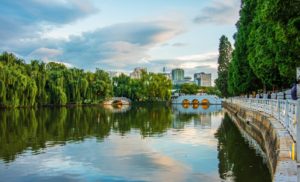
Welcome to Kunming, the Spring City of China! Upon arrival at the Kunming airport/train station, the local tour guide and driver will meet you in the arrival hall and escort you to your hotel.You’ll begin your journey to the diverse and captivating province of Yunnan from the capital city, Kunming.
After a short rest, stroll in the most picturesque park in Kunming urban area – the Green Lake Park,a charming area of tea houses and small boutiques selling handicrafts and beautiful local paintings.. Here you can share the happiness of local people’s doing tai chi, performing local opera, and other vibrant activities. If you visit the park in November or December, you will see the grandeur of huge flocks of red-beaked seagulls that migrate there from Siberia.
Day 2 Kunming-Shilin County
Sightseeing and Activities: Western Hills, Dianchi Lake, Yunnan Ethnic Villages, Yunnan Nationalities Museum
Accommodation: Shilin
Meals: Breakfast, Lunch
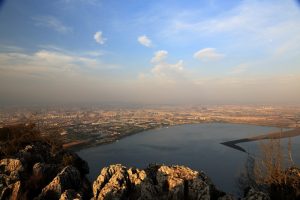
This morning, drive to visit Western Hills. Western Hills boasts an excellent environment with flourishing flowers and dense forest, providing tourists an excellent environment to enjoy the tranquility and marvelous scenery. They have also been given another name – ‘Sleeping Beauty Hills’ for the hills because its skyline looks like a beautiful young lady laying beside Dianchi Lake with her face upward and her hair trailling into water. In the Western Hills, Huating Temple, Taihua Temple, and Sanqing Pavillion are shaded by flourishing woods and tall bamboo bushes. The exquisite Dragon Gate Grotto is built along the precipice cliff.
After lunch, transfer to Yunnan Ethnic Villages. This theme park displays the colorful folklore and architecture of 25 ethnic groups residing in Yunnan Province. The theme park offers shows and performances, folklore and wax museums, as well as replica buildings found in the villages of each ethnic group.Villages of over 25 minorities including the Yi, Dai, Miao, Jingpo, Wa, Hani, Naxi, Dulong and others have been built here. Through various displays and re-creations of the original villages, the Yunnan Ethnic Village displays the diverse local ethnic culture. Villages of different styles are well arranged and show visitors their unique charm. Displaying a variety of buildings, lifestyles, and religious beliefs in the region, the village is a microcosm of Yunnan’s colorful and diverse ethnic culture.
Afterwards, walk to Yunnan Nationalities Museum. Yunnan Nationalities Museum is located on the east bank of Dianchi Lake next to Yunnan Nationalities Village in Kunming City, China. Completed in 1995, it is a comprehensive ethnology museum. Covering an area of over 200 mu, the museum has a building area of 130,000 square meters. It consists of various exhibition halls, office building, report hall, storage and workshops. The ecological environment, religious customs, culture and arts and ethnic relics of the ethnic groups of Yunnan are collected in it.
Day 3 Shilin-Luliang-Luoping
Sightseeing and Activities: Stone Forest, Luliang Colorful Sand Forest, Luoping
Accommodation: Luoping
Meals: Breakfast, Lunch
In the morning, visit Stone Forest (90 kms away, 1.5 hrs’ drive) which is a world natural heritage site and world geological park with amazing karst limestone landform, in the meantime, visit local villages and meet the local Yi ethnic minority people there.
Drive to Luliang County,visit Luliang Colorful Sand Forest, and then drive to Luoping which is known for its rape flowers, every spring, a rape flower festival is held there.
Day 4 Luoping
Sightseeing and Activities: Jiulong Waterfalls, Luobuge Gorge, Duoyi River, Buyi Ethnic Villages, Thousands of Mountains, Rape Flowers Festival
Accommodation: Luoping
Meals: Breakfast, Lunch
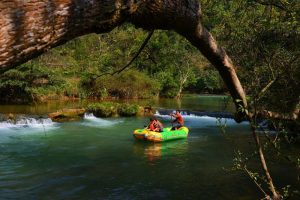
Visit Lubuge Gorge (known as “Small Three Gorges”) and the picturesque Duoyi River which is 12 kilometers long with waterfalls at different levels, where you can also have a glimps of the water mills that shows how the ancient people made use of the natural water resources, then visit Jiulong Waterfalls, a cluster of spectacular waterfalls formed on the Jiulong River, the greatest waterfall there has a drop of 56 meters with width of 112 meters.
Note: If this tour happens during the Rape Flowers Festival from Feb to Mar, you will have one more day option to explore the rape flowers sea in Luoping.
Day 5 Luoping-Qiubei-Puzhehei
Sightseeing and Activities: Puzhehei Scenic Area, Xianren Cave, the boat cruise, Yi and Miao ethnic villages
Accommodation: Puzhehei
Meals: Breakfast, Lunch
Drive to Puzhehei, Qiubei, Wenshan prefecture (3.5 hrs), visit Puzhehei Scenic Area, take a small boat to visit the Karst landscape and lakes, enjoy the local rurality. During your boat cruise, you will see large scale of lotus flowers on the lake. Then disembark at the Qinglongshan wharf and climb Qinglongshan Mountain to see the panorama of Puzhehei. After that, walk to visit the Torch Cave and Kwan-yin Cave.
Day 6 Puzhehei-Bamei
Sightseeing and Activities: Swan Lake, Bamei Village, Big Banyan Tree
Accommodation: Bamei
Meals: Breakfast, Lunch

This morning, visit some villages in the scenic area to experience local life. Then visit the “Swan Lake”. After lunch, drive to Guangnan County, then take a boat to Bamei village by passing through the caves. After landing, visit Bamei Village and the Big Banyan Tree, enjoy the peaceful life of Zhuang ethnic people.
The Bamei Village is located on the common boundary of Ake Village and Bada Village in the north of the Guangnan County,Wenshan. It belongs to the Karst topography. The Village is surrounded by green mountains, and through the Village runs all the year round a clear river which is called Tuoniang River. The most interesting thing about the village is that people have to go through a deep and sombrous water cave by boat whenever they want go in and out.When you emerge from the tunnel you will be amazed. In a hidden valley, among a grove of green bamboos and old trees, lies Bamei Village. A blue stream gently flows by, and hard-working farmers silently till the green fields. It’s a picture of another lost Shangri-la. Due to inconvenient location and hard transit, the village escaped attacks by outsiders and the influences of the modern world, staying as unadorned and as pure as they always were. A well-preserved environment and sub-tropical climate made the area a “Promised Land” for the inhabitants.
Day 7 Bamei-Babao
Sightseeing and Activities: Bamei River, Pisa Village, Yanshan County
Accommodation: Babao Town of Wenshan
Meals: Breakfast, Lunch
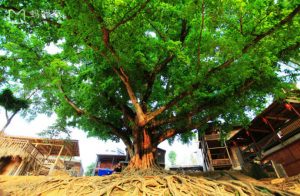
This morning, walk around in Bamei village and visit Bamei River. Have your free time, and enjoy the local life in this village. After lunch, take the boat to get out of the village from another cave.
Then drive to Yanshan County. On the way, you will visit a pure and quaint village of Zhuang ethnic people-Pisa Village(批洒村)in Zhela Township(者腊乡).
Transfer to Babao Town where you will visit the typical Karst landform. Stay in Babao Town.
Day 8 Babao-Yanshan-Gejiu-Jianshui
Sightseeing and Activities: Sanla Waterfall, Shadian Grand Mosque, Jianshui Old Town
Accommodation: Jianshui
Meals: Breakfast, Lunch
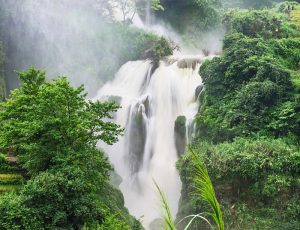
This morning, drive from Yanshan County to Gejiu City in Honghe Autonomous Prefecture for lunch. Then drive to visit the Grand Mosque of Shadian. Grand Mosque of Shadian was originally built in the year of 1684. After several restorations and reconstructions, the new Grand Mosque of Shadian is built into a large-scaled mosque with a construction area of 18,000 square meters. It is able to hold a capacity of 10,000 people to do prayers at a time.
Afterwards, transfer to Jianshui County. Visit Jianshui Old Town and Chaoyang Gate. The ancient city wall of Jianshui was built 600 years ago in Ming Dynasty. Today only Chaoyang tower at the East Gate and Qingyuan tower at the West Gate is left standing. It’s the landmark of Jianshui Ancient Town. Then visit Zhu Family Garden and old wells. The Zhu family garden is a local residence with distinctive features. It was built 100 years ago by a merchant named Zhu. The garden is built as a maze. It’s made up of many courtyard-style folk houses. The houses maintain the upturned eaves, the vivid paintings and the exquisite carvings on the roof beams.
Day 9 Jianshui-Yuanyang
Sightseeing and Activities: Jianshui Confucius Temple, Tuanshan Village and the Garden of Family Zhang, terraced fields of Laohuzui
Accommodation: Mengnong Chieftain Palace
Meals: Breakfast, Lunch
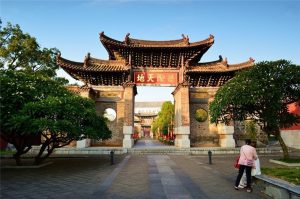
In the morning, visit the Confucius Temple, which has a history of 700 years. It is the second largest Confucius Temple in China. Then you’ll visit Tuanshan Village and the Garden of Family Zhang; Tuanshan Village is a rare surviving example of an intact-albeit neglected-traditional walled Yunnan village compound in southwestern China, and has been added to the 2005 list of internationally significant sites by the World Memorial Fund for Architecture (WMF), an international fund for the protection of world heritage sites.
In the afternoon, you will transfer to Yuanyang and enjoy the sight of terraced fields of Laohuzui (Tiger Mouth) at sunset. Overnight at Mengnong Chieftain Palace.
–Yuanyang is about 300km south of Kunming, renowned for its rice terraces, which claim as the world’s largest and most spectacular one, crafted out by bare hands by the Hani people one thousand years ago and is still in use today. The rice farmers have had to practice ecology and land preservation centuries before those concepts were widely accepted around the world. Without hard work maintaining the terrace walls and irrigation system, the precious top soil would wash down the hillsides into the rivers.
Yuanyang Rice Terrace is a self sustaining ecosystem. During winter to early spring, the entire field is irrigated with spring water from the forest above to rejuvenate and getting prepared for the next season. The Hani people have repeated this for more than a thousand years. There is only one harvest in a year for the Yuanyang Rice Terrace; planting is from March to Oct./Nov. every year.
Optional Sightseeing and Activities:
Lengdun Village of Baohe Town in Gejiu City(个旧市保和乡木花果村委会冷墩村)
Shadian Grand Mosque in Gejiu City (个旧市沙甸清真寺)
Abang Village of Jiasha Town in Gejiu City(个旧市贾沙乡陡岩村委会阿邦村)
Hetian Village in Gejiu City, Honghe(个旧市合田民俗村)
Jiajizhai Village and Pear Blossoms of Jijie Town in Gejiu City(个旧市鸡街镇加级寨村)
Day 10 Yuanyang
Sightseeing and Activities: the sunrise view of Duoyishu Rice Terraces, Bada Rice Terraces, Shengcun Market, Qingkou Village, the sunset view of Laohuzui Rice Terraces
Accommodation: Yuanyang
Meals: Breakfast, Lunch
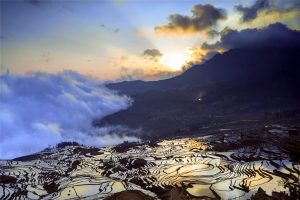
Get up every early in the morning, you’ll drive 30KM to visit Pugao Laozhai Village and enjoy the sunrise of Duoyishu Rice Terrace Fields when the sun appears above the eastern horizon. The terraced fields are ring upon ring and cascade one by one. They go along the hillside up to the sky. You will see the scenery of the terraced fields from the top of the mountains to the bottom. They are all farms under the sunshine and cloud and mist. The landscape is spectacular.
And then, you will visit Qingkou Village and rice terraces where Hani people for generations inhabit. Visit Bada Hani Rice Terrace, Shengcun Market as well.
Transfer back to Xinjie Town.
Day 11 Yuanyang-Luchun-Jiangcheng
Sightseeing and Activities: Laomeng Sunday Market, Lvchun Local Market, Lvchun Hani Ethnic Culture Museum, Lixianjiang River Valley
Accommodation: Jiangcheng
Meals: Breakfast, Lunch
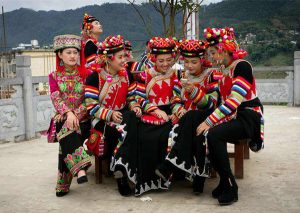
After breakfast, visit the local market in Xinjie Town. Depart from Xinjie Town,drive around 2 hours to Laomeng. If you are lucky enough, you will have chance to enjoy the Laomeng Sunday Market. Laomeng holds the most flamboyant market every Sunday. One can see people from six different ethnic minorities, with women and children dressing up in colourful dresses, different in their own traditional style.
Continue the driving along the banana forest and some rice terraces, you arrive at Lvchun County. Lvchun county, on the south western border of Yunnan Provice, China, just like its name, is a land where the green mountains spread out like a ribbon, the azure water always flows, the winter isn’t too cold, and the summer isn’t too hot.
Pay a visit Lvchun Local Market and Lvchun Hani Ethnic Culture Museum. The main cultural legacy of the worldwide Hani people over several thousand years of development is its unique immaterial culture. Therefore, this museum, in accordance with current advanced theory, has discarded the model of a traditional museum which simply displays a collection of implements, and adopted a model of bringing together local characteristics and the worldwide Hani culture.
After lunch, drive along the Lixianjiang River Valley to Jiangcheng Hani and Yi Autonomous County. Visit Lixianjiang River Valley, Hani ethnic villages, rice terraces on the way.
Optional Sightseeing and Activities:
Huanglianshan Mountain Nature Reserve in Luchun County(绿春黄连山保护区)
Dongzhu Rice Terraces in Luchun County(绿春桐珠梯田)
Lagu Hani Rice Terraces in Luchun County(绿春腊姑哈尼梯田)
Day 12 Jiangcheng-Zhengdong-Mengla
Sightseeing and Activities: Longfu Border, Monument of One Foot in Three Countries, Triple-border Boundary Tablet, Longfu Border Market, Jiangcheng Tea Plantation, Shiceng Dashan Mountain, Place Straddling, Mantan Village, Chenzisanzhai Village of Dai Minority,
Accommodation: Mengla in Xishuangbanna
Meals: Breakfast, Lunch
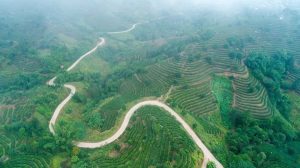
Jiangcheng Hani and Yi Autonomous County is an autonomous county under the jurisdiction of Pu’er City, in southern Yunnan, China, bordering Laos and Vietnam to the south, making it the only county in the province to border more than one country. By road, its seat, the town of Menglie (勐烈镇), is 520 km (320 mi) from Kunming and 145 km (90 mi) from Simao District, the municipal seat of Pu’er.
Drive 1hour to Qushui Town and visit Longfu Border between China,Vietnam and Laos including Monument of One Foot in Three Countries, Triple-border Boundary Tablet, Longfu Border Market (3th,13th,23th). Longfu Border, located in Shiceng Dashan Mountain (Ten Layers Mountain), is famous for the Place Straddling the border of China, Vietnam and Laos.
Drive back to Jiangcheng, visit Jiangcheng Tea Plantation.
Drive to Zhengdong Town, 60KM from Jiangcheng County. Visit Mantan Village and Chenzisanzhai Village of Dai Minority. Chengzi Sanzhai Village consists of Manhe Village (曼贺寨), Manhejing Village (曼贺井寨) Manluanzai Village(曼乱宰寨).
Mantan Village(漫滩傣族村) is a traditional village with Dai people’s characteristics. Dai people has lived there since the Emperor Yongzheng(雍正) of Qing Dynasty(1636 A.D-1912 A.D.). Up to now, Dai people have occupied 95% percent of the population in the village.
Well-reserved natural environment and ethnic dwellings make the village beautiful and quiet. No garbage can be seen when strolling along the roads in the village.
Chenzisanzhai Village(城子三寨村): a unique village with exotic flavors
About 8 kilometers away from Mantan Village sits the Chengzisanzhai Village. It is a small yet ancient village where Dai people have lived there for generations. Traditional customs of Dai people are intactly reserved in the village. Exquisite traditional houses of Dai people can be seen everywhere.
The village borders to Laos and Vietnam. Its unique geographical location contributes to Dai people’s close communication with Southeast Asian countries. Nowadays, local Dai residents still keep the custom of intermarriage with the Lao and the Vietnamese, which endows an kind of exotic flavor to the village.
Drive to Mengla County for overnight.
Options:
Bobiezhai Village of Guoqing Town in Jiangcheng County (江城县国庆乡么等村委会博別寨)
Yiwu Old Town in Mengla County(易武古镇)
Yiwu Ancient Tea Mountain(易武茶山)
Day 13 Mengla-Menglun-Jinghong
Sightseeing and Activities: Wangtianshu Scenic Area, Air Corridor, Menglun Tropical Botanical Garden
Accommodation: Jinghong in Xishuangbanna
Meals: Breakfast, Lunch
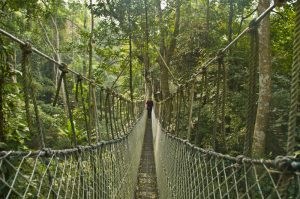
Visit Wangtianshu Scenic Area, which is the only oasis at 21 degrees north latitude, and has been recognized internationally as China’s unique tropical rainforest. Then walk in the Air Corridor (only the first entrance tickets of Wangtianshu Scenic Area and Air Corridor are included).
Drive to Menglun and take a tour of the Menglun Tropical Botanical Garden. As the home to many rare flora and endangered fauna, Xishuangbanna is an excellent place to take in the unique beauty of sub-tropical nature and biodiversity in China. Take a visit to the Menglun Tropical Botanical Garden and observe beautiful flowers, shrubbery, and trees in the spacious garden. If you go early enough in the morning, you can see the sunrise cast a dreamy golden glow over the garden.
Drive to Jinghong City for overnight.
Options:
Daka Village (Ake Ethnic People) of Menglun Town in Mengla County(勐腊县勐仑镇大卡村(阿克寨)
Day 14 Jinghong
Sightseeing and Activities: Ganlanba Morning Market, Dai Ethnic Garden, Mengle Great Buddha Temple, Manting Park, enjoy Dai Water Splashing Festival
Accommodation: Jinghong in Xishuangbanna
Meals: Breakfast, Lunch
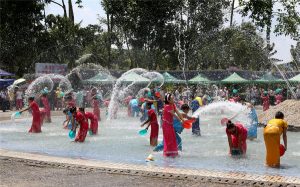
Take one day tour to Ganlanba Morning Market, Dai Ethnic Garden, Mengle Temple.
In the morning visit Ganlanba Morning Market, water Dai villages, Burmese temple and rubber garden on the way. Visit Dai Ethnic Garden, located in the Ganlan Basin in Menghan County, proudly holds a national 4A rating as one of China’s top scenic spots. Within the Dai Ethnic Garden, five Dai villages – Manjiang, Manchunman, Manting, ManZha, and Manga – cover an area of 3.36 square kilometers and consist of 309 families, or 1487 individual villagers.
Transfer back to Jinghong in the afternoon and pay a visit Mengle Temple. Mengle Great Buddha Temple was built to memorize a beautiful Dai Minority queen who was a pious Buddhist during Ming dynasty (1368-1644), which was destroyed during a war in 1848 and what we see today was rebuilt in 2007. Notable for its peculiar shape which resembles a sitting Buddha, Mengle Great Buddha Temple, the largest Theravada Buddhist temple in China, is the most sacred and important religion site of Dai people.
Visit Manting Park which is a modern park that measures about 30 acres in Jinghong in Xishuangbanna. It has a large new Buddhist temple called Zongfo Si. There is a display of ethnic architecture, and people entertain themselves by water fights during the Dai Water Splashing Festival each year. Entertainment is presented in the evening.
Day 15 Jinghong-Menghai-Jingmai
Sightseeing and Activities: Jingmai Tea Mountain, Jinghong in Xishuangbanna, Mengjinglai Dai Ethnic Village, One Tree Forest, Jingzhen Octagonal Pavilion,
Accommodation: Puer
Meals: Breakfast, Lunch

Transfer to Daluo Town, visit Daluo Border between Myanmar and China, Daluo town is located in southwest of Menghai County. The southeast is Bulangshan Mountain, the southwest and west are bordering on the Myanmar with the national boundary of 36.5 kilometers.With a total area of 400 square kilometers and superior geographical advantage, and being 81 kilometers away from Menghai County, Daluo is an important port in Yunnan province.
Visit Mengjinglai Dai Ethnic Village. Mengjinglai is the most outstanding China-Myanmar village. It’s located in the southwest of Xishuangbanna, Menghai Town. The crystal clear Daluo River flows from the west of the village forms the natural borders for both countries.
Visit One Tree Forest. Some aerial roots will grow from the trunk of the big banyan tree to whose base they would twine. Through the branches of the banyan tree breaks 32 aerial roots that are hanging down into the earth to be an aerial roots jungle. These straight aerial roots stand in lines like the soldiers who protect their motherland at the frontier, which makes people respectful. Therefore, the One-Tree-Forest scenery in Da Luo town is indispensable for the tourists to Xishuangbanna.
Transfer to Xiding Town, visit Xiding Thursday Market if it is the market day today.
Visit Zhanglang Bulang Ethnic Village.
Drive to Menghai County, pay a visit to Jingzhen Octagonal Pavilion. Jingzhen Octagonal Pavilion was built in 1701 during the Qing Dynasty (1644-1911) — the year 1063 according to the Dai calendar. It was originally built in a local Hinayana temple, but the temple was destroyed. The pavilion has retained its former features following three large-scale repairs.
Then drive to Jingmai Village in Huimin Town of Lancang County.
Options:
Day 16 Jingmai-Lancang-Menglian-Ximeng
Sightseeing and Activities: Jingmai-Lancang-Menglian-Ximeng, Lancang Huimin tourist town
Accommodation: Puer
Meals: Breakfast, Lunch
Lancang Huimin tourist town(惠民旅游小镇)(60 Kilometer about 1-hour’s drive) — Jingmai Mangjing Scenic Area(18.7Kilometer about 33-minutes’ drive), including Dapingzhang ancient tea garden, Nuogan water village of Dai, the ancient village of Wengji Blang, Tea Ancestor Temple, — Menglian Xuanfu Sishu(孟连县宣抚司署) — Menglian Golden Pagoda, Menglian Nayun Ancient Town (111 Kilometer about 3-hours’ drive) — Ximeng Mengsuo Longtan Lake (60 Kilometer about 2-hours’ drive) — Muyiji Holy Valley (5 Kilometer about 34-minutes’ drive).
Day 17 Ximeng-Shuangjiang-Cangyuan
Sightseeing and Activities: Ximeng-Shuangjiang-Cangyuan, Icelandic village, tea-making, tea-tasting, Shuangjiang village
Accommodation: Lincang
Meals: Breakfast, Lunch
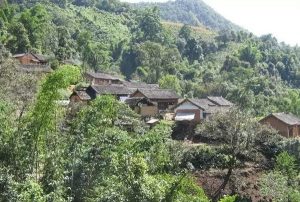
After breakfast, head to Icelandic village from Shuangjiang village to experience making tea by hand. Then after lunch, back to Mengku tea shop to enjoy tea-tasting and visit farmer’s tea-making process.
Mengku Icelandic village ( “Bingdao” in Chinese) in Shuangjiang County, the famous ancient tea village, rich and famous for its large leafed Iceland tea, is one of the county’s first place for cultivating tea. Iceland tea is the main part of the famous Mengku large leafed tea and Icelandic village is the main birthplace of Mengku Tea. This kind of tea has a long history. There are written records during the Ming Dynasty (around 1485), or earlier than Ming period according to the storied unwritten records. As to the origin of the Iceland tea, some believe it was introduced from Xishuangbanna ancient mountain by local Chieftain, while others believe it was introduced from other places.
Day 18 Cangyuan
Sightseeing and Activities: Cangyuan Cliff Painting,
Accommodation: Lincang
Meals: Breakfast, Lunch
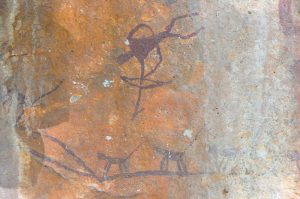
After breakfast, head to visit Cangyuan Cliff Painting. Lincang rock painting is located in the north of Menglai town, Cangyuan county and famous for the 3500- year old rock painting. Up to now, there are 11 pieces of rock paintings found in batches in 1965, 1978 and 1981, mainly distributing in Mengsheng township(勐省乡) and Mengyuan township(勐来乡) , which vividly show the Wa’s activities of hunting, herding, dancing and sacrificing, rich in content and unique in style. So far, Cangyuan rock painting is one of the oldest rock paintings found in China. According to the determination of drawing age,
the rock paintings were measured in the late Neolithic period which is more than 3,000 years ago. On June 25, 2001, Cangyuan rock painting, as a Neolithic relic, was included by the State Council of China in the list of the fifth batch of national relic protection units.
Visit Thousand-Meter Gallery of Chinese painting in the afternoon. Located in the middle part of the scenic area, the mural is about 3 kilometers long, 80-180 meters high and the highest 280 meters. Some cliff surfaces are uneven densely covered with honeycomb dissolved pore, some are smooth just as being cut by a knife or axe, and some are similar with terrace dotted to be colorful by impurities and climbing plants. It is like a giant mural painting, which depicts the vicissitudes of the old earth.
Day 19 Cangyuan-Gengma-Zhenkang
Sightseeing and Activities: Tea-making, pottery-making,
Accommodation: Lincang
Meals: Breakfast, Lunch
After breakfast, head to the scenic spots. Have you own DIY experience in Pu ‘er tea base, and visit Pu ‘er tea farmstead to enjoy tea-tasting and learn local tea culture. Then, go to tea factory to have DIY fun of making tea! Next go to experience Mengyong pottery-making. Drive to Zhenkang county for overnight.
Mengyong pottery and Pu ‘er tea base is a part of the intangible cultural heritage of Yunnan minorities, which is non-commercial and pay more attention to personal experience of tourists.
Day 20 Zhenkang-Mengyang-Mangshi
Sightseeing and Activities: Nujiang River, original forest and ethnic villages
Accommodation: Mangshi in Dehong
Meals: Breakfast, Lunch
Nujiang River, original forest and ethnic villages
Day 21 Mangshi-Wanding-Ruili
Sightseeing and Activities: Menghuan Grand Pagoda, the Peacock Lake, the Pagoda wrapped in the tree, Moli Waterfall and Rain Forest, Jiegao Myanmar and China Border
Accommodation: Ruili in Dehong
Meals:
Menghuan Grand Pagoda, Peacock Lake, the Pagoda wrapped in the tree, Moli Waterfall and Rain Forest, Jiegao Myanmar and China Border
Day 22 Ruili-Longchuan-Yingjiang-Lianghe-Tengchong
Sightseeing and Activities: Jiele Golden Pagoda, One Tree Forest, Dayingjiang River, Nandian Xuanfu Chieftain Palace
Accommodation:
Meals:
Jiele Golden Pagoda, One Tree Forest, Dayingjiang River, Nandian Xuanfu Chieftain Palace
Day 23 Tengchong
Sightseeing and Activities: Rehai Hot Spring, Beihai Wetland Park, Heshun Ancient Town
Accommodation: Tengchong
Meals: Breakfast, Lunch
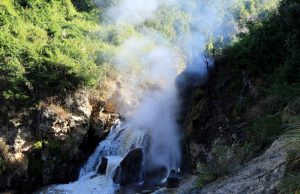
This morning, drive to Rehai Hot Spring. Tengchong is one of China’s three major geothermal areas, known as “Land Abounding in Geothermal Resources”. There are plenty of springs of hot water and hot vapour, called “Hot Sea”. There are quite a number of hot fields as well. Tengchong is a resort where people can travel, take a bath and have medical treatment. The Hot Sea, with an area of 9 square kilometers, lies 20 kilometers away southwest of the county seat and in the center of the geothermal area. There are over 80 springs of hot water and hot vapour, of which there are 14 spring whose temperature reaches 90¡ãC. The spring can be regarded as a rarity as far as their number and geothermal energy are concerned. The most magnificent view is the boiling pool with a temperature of 97¡ãC, so it is called “the Big Boiling Pot” by the local people. There are dozens of big springs of vapour with a temperature of 94¡ãC at the mouths of the springs, where you can steam food.
After that, drive to Beihai Wetland Park. The wetland is surrounded by mountains, located in a special geographical position, and is a typical subtropical volcanic lava barrier lake marsh wetland. The reserve features a “floating blanket style” marsh, complex biodiversity and high productivity. The reserve is not only a garden of national protected plants like Brasenia schreberi and wildwater chestnuts, but it is also a paradise for water birds.
In the afternoon, arrive in Heshun Ancient Town in Tengchong County in the late afternoon, you will be free in Heshun Ancient Town and enjoy the relax life after the wonderful Three Parallel River Grand Canyons adventure tour. Walk around Heshun Old Town, pay a visit to Clothes-Washing Pacillion, Heshun Library,Wenchang Temple and the Anti-Japanese War Museum as well as the local ancient houses.
Day 24 Tengchong-Liuku-Fugong
Sightseeing and Activities: Gaolig Gongshan Mountain Nature Reserve, Nujiang River, Laomudeng Village.
Accommodation: Nujiang
Meals: Breakfast, Lunch
Leave Tengchong, drive to Liuku. Enjoy your day at Nujiang Grand Canyon and visit Laomudeng Village and the bathhouse of Lishu Nationality. It is a tradition to welcome new year that all people take a bath together in the open hot springs by the banks of the river. Then go on driving to Fugong. Sightseeing includes a visit to a suspension bridge and a glide cable. Special Lishu food will be served during dinner. In the evening you will take part in a party with the local people.
Day 25 Fugong-Gongshan-Bingzhongluo
Sightseeing and Activities: Nujiang Grand Canyon, Nu ethnic village, the Suspension Bridges
Accommodation: Bingzhongluo
Meals: Breakfast, Lunch
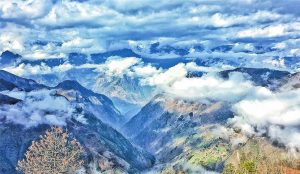
Drive from Fugong to Gongshan (4-hour’s drive), the scenery just got better and better: the river twisted and turned, the valley sides became steeper and there were huge crags and mountains rising beyond-Myanmar was only a few km away over the crest of these green hills. We will pass the famous Shi yue liang, the so-called “bright moon in the mountain”, about an hour outside of Fugong, and source of many Lisu and Nu folkstories. Stop to see the first Bend of the Nujiang River (Salween River) and Mt. Gaoligong. You could also try crossing the Nujiang River hanging from a rope, the Liusuo, a traditional way to cross the river in the olden days when there was no bridge. Then drive to Bingzhongluo (2-hour’s drive).
Day 26 Bingzhongluo
Sightseeing and Activities: Nujiang Grand Canyon, Bingzhongluo Village, Nujiang River (Salween River), the First Bend of Nujiang River, Qiunatong Village, Wuli Village, Dimaluo Village, Chongding Catholic Church
Accommodation: Binzhongluo
Meals: Breakfast, Lunch
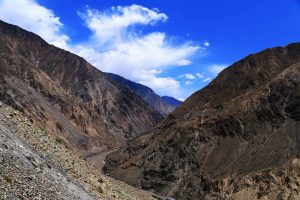
You will have a beautiful hiking tour in Bingzhongluo including the attractions of Qiunatong Village, Wuli Village, Dimaluo Village, Chongding Catholic Church and Nujiang River Grand Canyon.
There are easy and beautiful walks to nearby villages along the Nujiang. A few kilometers outside of town, the river widens and cuts through very deep and dramatic gorges. The road hugs the Nujiang and landslides occur from time to time along the way. It is said that the scenery is especially spectacular after rain, however this also increases potential delays and exacerbates the danger from landslides.
The most beautiful part of Nujiang Gorge starts from Binzhongluo, the northernmost town of the Gorge, where the essential attractions of the Nujiang Gorge are located. Hiking is the best way to enjoy the landscape and an average of 2.5 hours is needed for most tourists to reach the famous “Tea Horse Caravan Route.” Renting a mini bus at Bingzhongluo town is an alternative for the less adventurous sightseers.
On the way to the “Tea-Horse Caravan Route”, one can see the 100-year-old Zhongding Catholic Church built and founded by a French missionary. Shimen Pass is another fantastic section of the gorge along with Wengli (also called Wuli), another stunning landscape lying on a beautiful slope along the river bank. Very near to the Wengli, a carved path is seen on the other bank cliff, the so-called “Tea-Horse Caravan Route”, a path used by traders ferrying their goods between Yunnan and Tibet. At the end of the trekking road, an old hanging bridge and a new one-year-old bridge swing side-by-side.
To those wanderlusts, some trekking routes are worthy of spending days or even weeks longer between Gongshan and Bingzhongluo. Getting 90km further west to the Drung River from Gongshan reveal beautiful virgin forests as well as the kind-hearted Drung ethnic people living their old way of life.
Day 27 Bingzhongluo-Gongshan-Cizhong
Sightseeing and Activities: Nujiang Grand Canyon, Dulong ethnic village, Biluo Snow Mountain, Laowo Mountain
Accommodation: Cizhong in Diqing
Meals: Breakfast, Lunch
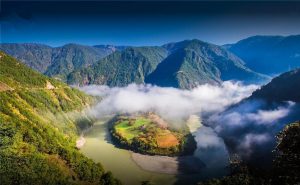
Drive from Bingzhongluo to Gongshan. Stop to visit the First Bend of Nujiang River. Continue the driving along Nujiang Valley to Gongshan County
Drive along the newly built road from Gongshan County to Cizhong,the road is bumpy but the scenery is so fantestic because the view of Mekong River and Nujiang River grand cayons as well as the Biluo Snow Mountain.
Biluo Snow Mountain is located at Lanping churchyard which I continuous 145KM. There are 15 snow mountains, which stand 4000 meter above sea level. The Laowo Mountain is the most beautiful a highest mountain than the others, which is 4500 meters above sea level. It is 3200 meters higher compared with the Lantsang. The original ecosystem has been preserved. The climate changes unconventionally in the mountain. The flowing waterfall is densely 6 covered, edelweiss and lakes are gathered, and it is called the mountain with thousand waterfalls and thousand lakes.
Day 28 Cizhong-Meili Snow Mountain-Feilaisi
Sightseeing and Activities: Tibetan Catholic Church, Feilaisi, Meili Snow Mountain, Three Parallel Rivers of Yunnan Protected Areas,
Accommodation: Feilaisi
Meals: Breakfast, Lunch
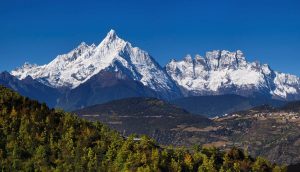
Visit the Tibetan Catholic Church built by French missionaries in 1867, the church is used by Tibetan, Naxi and Lisu people. They still have the grapes planted by missionaries and old the traditional way of making wine. –Lancang River is the longest river flowing from north to south in China. It takes its source from the Zhaqu of the Guangguori Peak of Tanggula Mountain Range in Qinghai Province, China. It is called the Lancang River after it reaches Changdu. The river runs south until it leaves China at the Nanla Bay out of Yunnan Province and therefrom changes its name from the Lancang River to the Mekong River. The Grand Canyon of the Lancang River is famous for not only its deep and long vale, but also the rushing water. The river water is limpid and rushing in winter, but turbid and onrushing in summer. As the river becoming narrow in the Grand Canyon, high waves are striking against the banks and making a sound like thunder. What a fantastic spectacle! Such steep mountains, deep valley and miraculous geographic structure are seldom seen all over the world.
Drive to Mingyong Village. Hike from Mingyong village to Mingyong Glacier (2600m) which is the low altitude glacier of the lowest latitude in the world. Then you will trek down directly to the edge of Meikong River(2,050m/6,724ft) . Walk along the Mekong Grand Canyon and arrive in Xidang Village(2,200m/7,216ft) where you can visit some scattered Tibetan houses in the village.
Arrive in Feilaisi in the late afternoon, you will have a nice sunset view of Meili Snow Mountain from the Sightseeing Platform, where you can see the 13 white pagodas meaning of the 13 peaks of Meili Snow Mountain over 6,000 meters (19,685 feet) above sea level, known as the “Prince’s 13 peaks”.
–Meili Snow Mountain (Meili Xueshan), also called Kawakarpo, is a UNESCO nature site located in Deqin County dividing Yunnan from Tibet, a wonderful place to hike and explore both nature and Tibetan culture.Rising between the Salween River and the Mekong River in the extreme edge of Northwest Yunnan, the Meili Snow Mt. region is part of Three Parallel Rivers of Yunnan Protected Areas. Legend says that the Meili Snow Mountain is a god guarding Tibetan Buddhism. With 13 peaks over 6000m in the range, the main peak Kawakarpo (“Kawagebo” in Chinese) is a sharp snow mountain with an altitude of 6740m,which has never been conquered yet.
Day 29 Feilaisi-Shangrila
Sightseeing and Activities: Benzilan, Baimang Snow Mountain Nature Reserve, the First Bend of Jinsha River or Moon Bend
Accommodation: Shangrila
Meals: Breakfast, Lunch
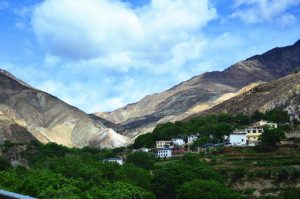
In the morning, drive back to Shangri-la. You will stop at Benzilan for lunch. Visit Baimang Snow Mountain Nature Reserve, you will be able to view Baimang Snow Mountain if the weather is clear, pass the top part of today at 4292m altitude at 156km. After that, visit the First Bend of Jinsha River or Moon Bend, which is the boundary between Sichuan and Yunnan. This is different from the First Bend of Yangtze River in Lijiang City. The bend in Shigu Town changes the flow direction of the Yangtze River but in Benzilan, the Moon Bend is just a grand bend between the mountains with an impressive scenery.
Day 30 Shangrila
Sightseeing and Activities: Songzanlin Monastery, Pudacuo National Park, Shudu Lake
Accommodation: Shangrila
Meals: Breakfast, Lunch
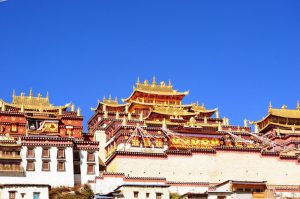
In the morning, visit the Ganden Sumtseling Monastery, the largest Tibetan monastery in Yunnan. Songzanlin Monastery has another alias ‘the little Potala Palace ‘, so named because the whole monastery is in the traditional style with mysterious atmosphere. Walk around Songzanlin Monastery.
And afterwards you’ll visit the tranquil Shudu Lake in Pudacuo National Park. Pudacuo National Park is located in one of the most biologically-diverse regions of the world. While the region comprises only 0.7 percent of China’s land area, it contains more than 20 percent of the country’s plant species, about one-third of its mammal and bird species and almost 100 endangered species.
Finally, you will visit a Tibetan’s family to experience the local life in the bonfire party with Tibetan dance and music and you will try Tibetan home-made yak and cheese.
Day 31 Shangrila-Lijiang
Sightseeing and Activities: Tiger Leaping Gorge, Bendiwan Village, Iron Chain Bridge, Red Army’s Long March Memorial Monument,
Accommodation: Lijiang
Meals: Breakfast, Lunch
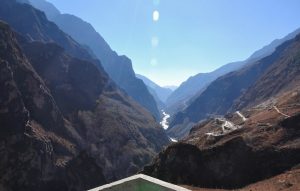
This morning, drive to visit the Tiger Leaping Gorge, the deepest gorge in the world. With 34 rapids of the Yangtze River, it is called the Jinsha in this area because you can find gold in the river. Start the hiking tour of the Tiger Leaping Gorge from the 14KM Point to Halfway Guesthouse in Bendiwan Village for lunch,you will enjoy the wonderful view of Tiger Leaping Gorge and Jade Dragon Snow Mountain from the balcony of Halfway Guesthouse. Trek 1 hour to the Guanyin Temple and Bamboo Forest, and then continue the hiking down to Tinas Hostel in the middle part of the gorge.Meet our driver and transfer to Shangrila.
Then drive to the First Bend on the Yangtze River with imposing gorge scenery, visit the Iron Chain Bridge, the Red Army’s Long March Memorial Monument in the Shigu town. The town of Stone Drum got its name from a large, cylindrical, marble tablet shaped like a drum. The scenery is magnificent as the road running through the Lijiang valley which is filled with wheat fields and drying haystacks.
In the late afternoon, transfer to Lijiang for overnight.
Day 32 Lijiang
Sightseeing and Activities: Jade Dragon Snow Mountain, Lijiang Ancient Town, Ganhaizi Meadow, Baishuihe River, Impression Lijang Ethnic Show, Baisha Village, Baisha Mural
Accommodation: Lijiang
Meals: Breakfast, Lunch
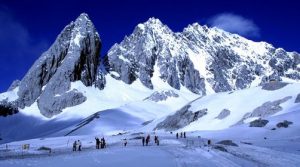
Enjoy the sunrise of the Jade Dragon Snow Mountain and Lijiang Ancient Town in the morning, drive about 30KM to Ganhaizi Meadow(3100M), you will take the sightseeig bus for a short visiting through the Baishuihe River, take the chairlift up to visit Jade Dragon Snow Mountain. The cableway will be arranged according to the condition of the mountain. You will hike around1 hours in the original forest in Spruce Meadow (3200M).
After lunch, you will enjoy the Impression Lijang Ethnic Show directed in Ganhaizi Meadow(3100M). A cultural show demonstrating the traditions and lifestyles of the Naxi, Yi and Bai peoples of the area. The show takes place inside Jade Dragon Snow Mountain Park at 3500m in an outdoor theater specifically designed to showcase the mountain which is used as a backdrop. The production itself was designed by Zhang Yimou, Fan Yue and Wang Chaoge, a cast of over 500 people, and a number of horses. In the afternoon, you’ll stroll through Baisha Village, which is an enchanting traditional Yunnan village. Visit the Baisha Mural about 600 years old, which is one part of the World Cultural Heritage by the UNESCO 1997.
–Jade Dragon Snow Mountain stretches a length of 35 kilometers (22 miles) and a width of 20 kilometers (13 miles). Looking from Lijiang Old Town in the south which is 15 kilometers (nine miles) away, the snow-covered and fog-enlaced mountain resembles a jade dragon lying in the clouds, hence, the name Jade Dragon Snow Mountain. The highest peak named Fan Peak (Shanzidou in Chinese) which is about 5596 meters above sea level. There are three cablecars in the mountain, the fist to the Glacier Park(4500M),the second to Spruce Meadow(3200M), the third to Yak Meadow(3700M).
Day 33 Lijiang-Lugu Lake
Sightseeing and Activities: Lugu Lake, Liwubi Island and Heiwawu Island, Mosuo Culture Museum, take part in Mosuo Bonfire Party
Accommodation: Lugu Lake
Meals: Breakfast, Lunch

In the morning, dive 4-5 hrs on the spectacle mountain road to visit the mysterious Lugu Lake. On the way, enjoy the beautiful view among the huge mountains and rivers.
Late afternoon, you will take the canoes to visit Liwubi Island and Heiwawu Island in Lugu Lake. Pay a visit to Mosuo Culture Museum and learn the Mosuo ethnic custom in the museum. Enjoy the sunset wonder of Luguhu Lake in Luoshui Village. In the evening, take part in Mosuo Bonfire Party with ethnic dance and singing performance. You will dance and sing with Mosuo boys and girls around a big bonfire in the outdoors theatre.
Day 34 Lugu Lake-Lijiang
Sightseeing and Activities: Zhamei Lamaist Monastery, Ancient Tea-Horse Trade Caravan, Mosuo Market, Ninglang Town
Accommodation: Lijiang
Meals: Breakfast, Lunch
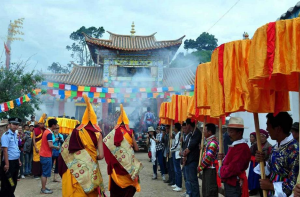
In the morning, you will drive about 20Km to visit the Zhamei Lamaist Monastery which is the biggest lamasery in Moso area Yongning Town. Tibetan people call Yongning as “taluo”, meaning “the way to heaven”. The place the Zhamei Lamasery lies in is called “Zhameige”, which means “no war”. The coincidence of these two names make the Lamasery even famous in Tibet.
Yongning Town is an important town of the Ancient Tea-Horse Trade Caravan from Yunnan to Tibet. Located between Yunnan and Sichuan, Yongning keeps the original ethnic life which is still not damaged by tourists. You will visit Mosuo Market in Yongning Town. We will arrange a Mosuo family to visit and have lunch in Mosuo family, enjoy the Mosuo real life in a village.
Afternoon, drive back to Lijiang. On the way to Ninglang Town,you will stop to visit a Pumi Ethnic Village and Pumi Family.The ancestors of Pumi were a nomadic tribe living in the southern part of Gansu Province and the eastern part of Qinghai Province. Later, their descendants moved south to warmer areas along the Hengduan Mountain Range. After the 13th century, the Pumi ethnic group gradually settled down in Ninglang, Lijiang, Weixi and Lanping counties.
Day 35 Lijiang-Shaxi-Dali
Sightseeing and Activities: Shibaoshan Mountain, Shizhong (Stone Bell) Hills, Shaxi Old Town, Dali Old Town, Foreigner Street, Erhai Lake
Accommodation: Dali
Meals: Breakfast, Lunch
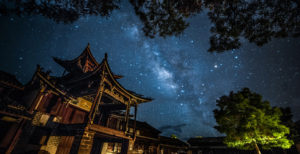
Morning , pick up from your hotel in Lijiang , drive to visit Shibaoshan Mountain. Located 25 km southwest of Jianchuan County, the Shibao (Stone Treasure) Hills are also called the Shizhong (Stone Bell) Hills. Built during the Tang and Song Dynasties, it is considered an official historical site.
Later go ahead to visit Shaxi Old Town The remains of an ancient market town and once an active trade stop on the Southern Silk Road that connected Tibet and China with Southeast Asia and on to Europe. This Road is actually older than the more famous Silk Road (in the North), predating it by at least 300 years. Shaxi has been listed by the World Monuments Fund as one of the world’s 100 most endangered sites.
After the tour , drive to Dali. Visit Dali Old Town. Walk around the Foreigner Street and enjoy the relax time with local people. After climbing up to the City Wall of Dali, you will have panoramic view of the Erhai Lake.
Day 36 Dali-Erhai Lake-Xizhou-Dali
Sightseeing and Activities: Three Pagodas in Chongshen Monastery,cruise in Erhai Lake, Xizhou Town, Xizhou Town,
Accommodation: Dali
Meals: Breakfast, Lunch
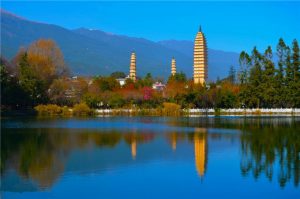
Visit the Three Pagodas in Chongshen Monastery which has a history of over 1,800 years located at the foot of Cangshan Mountain facing to the Erhai Lake. Three Pagodas are made of three ancient independent pagodas forming a symmetrical triangle.
After lunch, you’ll cruise in Erhai Lake by the small boat to the Jinsuo Islet in the east Erhai Lake. There are 200 Bai ethnic families around 1000 people in Jinsuo Island.In Erhai Lake cruise, you will enjoy the green Cangshan Mountain and the Three Pagodas from a far as well as lots of birds and seagulls flying over the lake.
After landing, you will head for Xizhou Town to fully appreciate Bai-style traditional architectural courtyards, taste their fragrant Three-Course Tea and explore their distinctive culture.
Day 37 Dali-Donglianhua Village-Weishan-Dali
Sightseeing and Activities: Donglianhua Village, Tea and Horse Road, Weishan Old Town
Accommodation: Dali
Meals: Breakfast, Lunch
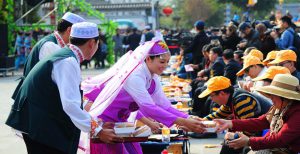
This morning, drive to Weishan County. You will visit Donglianhua Village first. During the Ming and Qing dynasties, they became involved in trade as caravan leaders on the Tea and Horse Road (茶马古道). The courtyards and mansions of village of Donglianhua (东莲花) shows how successful these Chinese Muslims traders were. The Muslims of Weishan (巍山) region in Yunnan (as well as other Chinese regions) belong to the Hui ethnic group (回族). The ancestry of the Hui varies. Some are the descendants of intermarriages between Muslim men of Middle-eastern or Central Asian origins and local women, others are the descendants of Han-Chinese who converted to Islam.
Then transfer to Weishan Old Town. Weishan Old Town is located at the foot of Ailao Mountain. It is a historical and cultural city known as the cradle of Nanzhao Kingdom. First built in Yuan Dynasty, Weishan Old Town has been changed to the brick city and remained the style and features until today. As the place that carry out Tusi System for the longest time in Yunnan, the long history of Weishan breeds numerous temples, echoing with the natural landscape at the diatance.
In the late afternoon, drive back to Dali.
Day 38 Dali-Yunnanyi-Chuxiong-Kunming
Sightseeing and Activities: Yi Ren Old Town, Yunnanyi
Accommodation: Kunming
Meals: Breakfast, Lunch
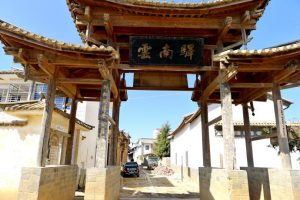
Drive from Dali to Yunnanyi. Yunnanyi is located in Xiangyun County of Dali Prefecture, about four hours’ drive from Kunming. As the earliest place named Yunnan(the place to the south of the colorful cloud), Yunnanyi is the former site of Yunnan County of West Han Dynasty and Yunnan Prefecture of Wei and Jin Dynasties; in the Yuan, Ming and Qing Dynasties, Yizhan (remount or post stations) were set here, so it is named Yunnan Yi. Due to its significant geographic location, Yunnan Yi used to be a must-take position since it can connect Dali, Chengdu, Kunming, South and West Yunnan; a time-honored ancient passage stretches through the small village with well conserved folk residences of Bai.
After lunch, drive to Yi Ren Old Town in Chuxiong City. The Yi Ren old town located at the west of Chuxiong economic development zone, Yunnan. And it is fuses both China and Yi minority national traditional culture as the main key of the antique construction. With fully Yi national minority’s characteristic the entire old town selects material from Yi national minority’s modeling, totem and the color.
In the afternoon, drive to Kunming for overnight.
Day 39 Departure from Kunming
Sightseeing and Activities: Depart from Kunming
Accommodation:
Meals: Breakfast
Depart from Kunming. Service ends.
Recommended Hotels
| Destination | 5 Star | 4 Star | 3 Star | Hostels |
| Kunming | Sofitel Hotel | Kunming Jinjiang Hotel |
Kunming Longteng Hotel |
T&T Story Hotel |
| Shilin | Days Hotel and Suites Tongce Shilin of Wyndham | Bosheng Holiday Hotel | Ashima Business Hotel | Local Hostel |
| Luoping | / | / | / | Local Hostel |
| Puzhehei | / | / | / | YI DA Inn |
| Bamei | / | / | / | Local Hostel |
| Jianshui | Tinziyun Resort |
Lin’an Hotel |
Hongmantian Hotel |
Local Hostel |
| Yuanyang | The Twelve Manor Terraces Hostel | Yunti Hotel (Yuanyang Shengcun) |
Yunshuijian Guesthouse |
Local Hostel |
| Jinghong (Xishuangbanna) |
Jinhong Qixi Hotel |
Jinghong Ninty-Seven Daiyun Theme Hotel | Fanyin Shuyuan Hotel | Jinghong Daixiang Vocational Hotel |
| Lincang | / | Hetang Yuechun Hotel | Yuncheng Hotel | Local Hostel |
| Dehong | Mangshi Hotel | Jingcai Hotel | Huangjia Hotel | Local Hostel |
| Tengchong | Tengchong Guanfang Hotel | Tengchong Empark Grand Hotel | Tengchong Dongfang Xuanyi Holiday Hotel | Local Hostel |
|
Bingzhongluo |
/ | / | / | Local Hostel |
|
Cizhong |
/ | / | / | Songtsam Lodges Cizhong |
| Feilaisi | Guanjing Tiantang Hotel | Mingzhu Hotel | Mingzhu Hotel | Local Hostel |
|
Shangrila |
Tianju Shangri-la |
E-outfitting Boutique Hotel |
Bodhi Boutique Inn | Wu Fu South Yunnan Boutique Inn |
| Lijiang |
InterContinental Hotel |
E-outfitting Boutique Hotel in Shuhe |
Baisha Holiday Hotel | Local Hostel |
| Lugu Lake |
Sealily Lugu Lake Angyue Boutique Hotel |
Sealily Lugu Lake Honeymoon Solu Boutique Holiday Hotel |
Sealily Travel Hotel |
Local Hostel |
| Dali |
Hilton Dali Resort And Spa |
Dali E-outfitting Boutique Hotel |
Taiheju Hotel |
Dali Fengxue Gucheng |
Service Included:
- Admission fees for all of the sightseeing spots listed in the itinerary;
- Meals as listed in the itinerary;
- Hotels as listed in the itinerary;
- Private English-speaking tour guide;
- Private vehicle for transfers & sightseeing with skilled driver;
- Service charge & government taxes;
- Luggage transfers between airports and hotels;
- Domestic train tickets of soft sleeper.
Service Excluded:
- Any arrival and departure international airfares or train tickets;
- Chinese visa fees;
- Excess baggage charged by Airlines;
- Single room supplement;
- Tips to guides and drivers;
- Personal expenses and gratuities to service staff;
- Personal travel accident insurance;
- All optional programs.
Travel Tips:
- Visitors are advised to always carry changes of clothing due to the large variations in temperature between day and night.
- The climate is relatively dry, so drink more water every day.
- Protecting oneself from strong UV radiation at high altitude.
- Protecting oneself from altitude sickness. Lessen the effects of altitude sickness, avoid strenuous exercise and have plenty of rest.
- Respect local customs , habits, and religious beliefs.
The experience of travel is unique, for me I enjoy sincere interaction with the people I meet, in the places I go. I generally, travel solo to do this. But, in countries where I do not know the language, or I am unable to read the writings, I engage in a tour, a private one if possible. This is what I did, when make the decision to add China to a world tour I was on in 2016. I was referred to Yunnan Exploration, by my brother and sister-in-law who had been teaching English in Yunnan Province, for the prior two years.
When I contact, Yunnan Exploration, and explained to them, I wanted travel that not only visited the sites, but also would give me an intimate interaction with the people I met on the way, they assured me they could do this.
And this they did, starting off, with themselves, Charlie the owner, his assistant Sue, guide Lolita and their driver all joined me for dinner at, where we discussed their life’s in Lijang. The dinner was then followed with a visit to Sue’s family home where I was able to experience Chinese home life, and spend time with her mother and father who are contemporary creators, the mother an artist and the father a musician and teacher.
Also included in the trip was a, where the hostel manager, Carol invited me to join her family, (Mother, Father, siblings and friends) for a traditional dinner. I was able to interact with the family in such a way, that I felt like family. On my last day, I was staying next to the Naxi embroidery school, which was open to tours, but I went as an individual. It was a school my sister-in-law had taught, and I was impressed with the English spoken there. As we had lunch, we decided to make a video, to record their linguistic accomplishment and share it with the public. Before I departed, they took the time to work with me, to make the ‘We speak English Here Video’, a unique experience that made my trip with Yunnan Travel, more than just a sightseeing tour.
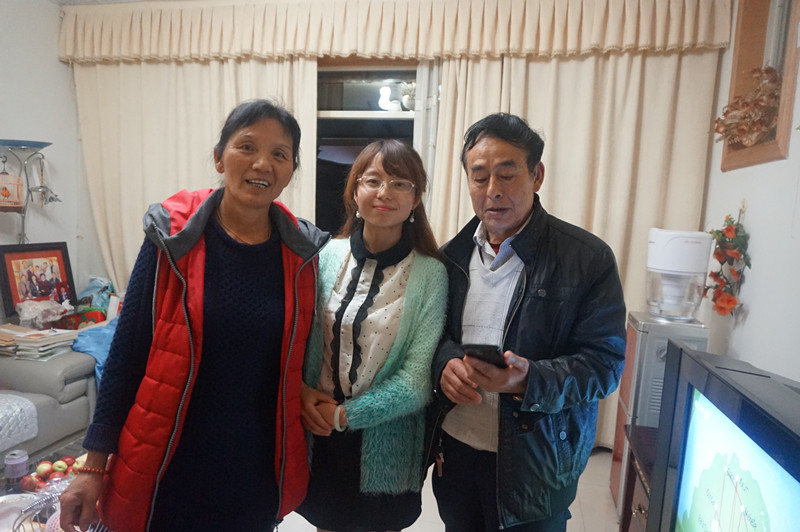
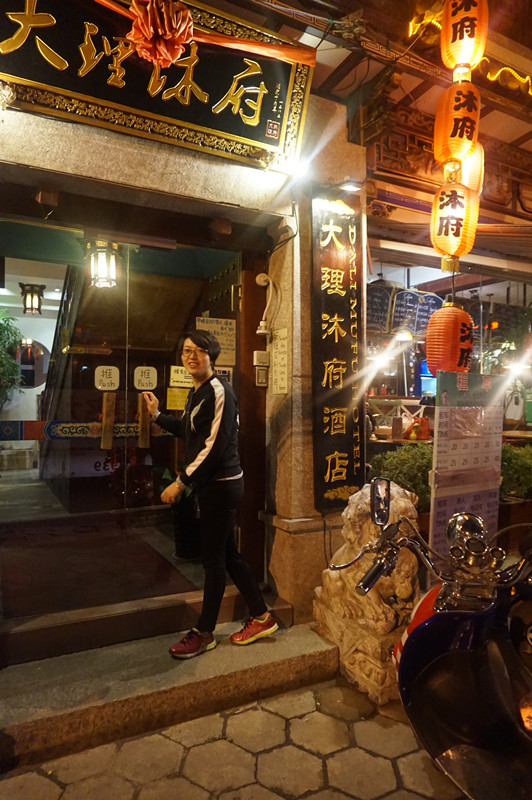
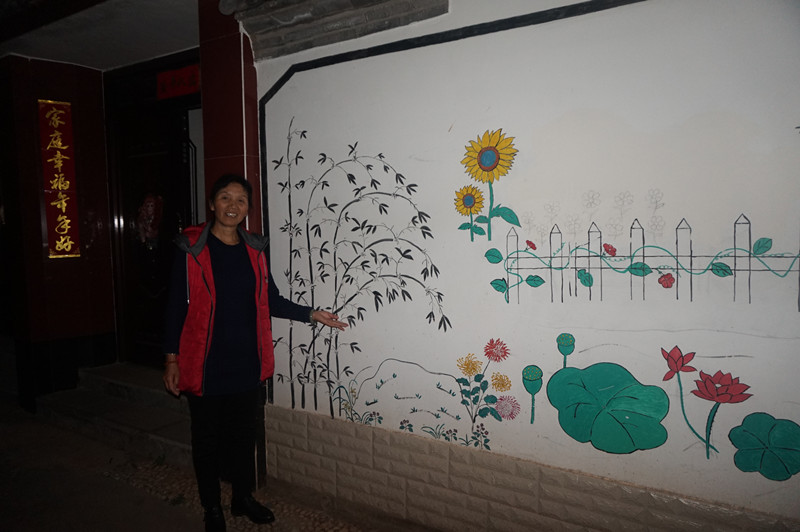
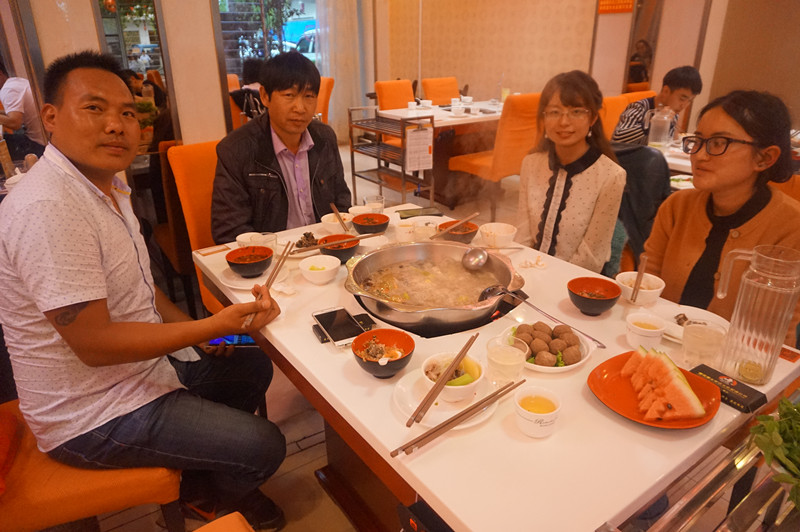
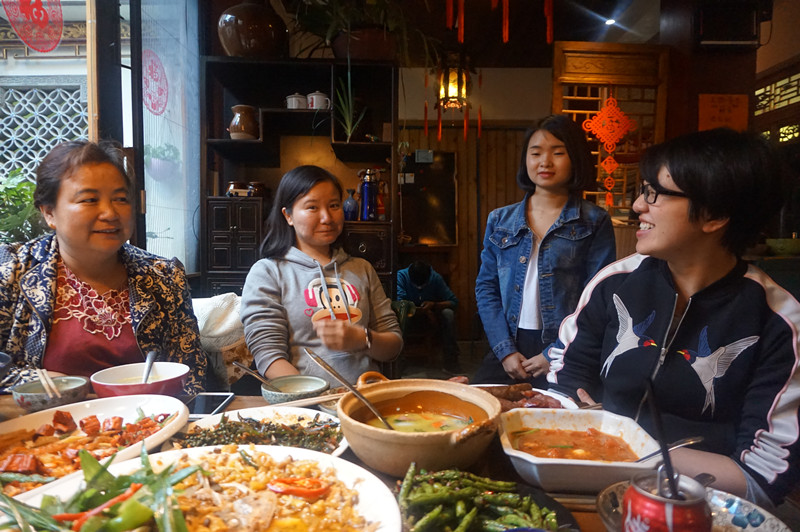
Geographic Location
-
Address: The area within 20 square kilometers centered on Huagou Village and Huashitou Village in Hongtudizhen, Dongchuan District, Kunming, Yunnan Province.
-
Transportation:
-
By Bus: You can take a bus to Fazhe from Kunming North Bus Station and get off at Huashitou Village. The fare is about 37 yuan per person, with two buses departing at 7:50 and 8:30 every day. Alternatively, you can take a bus to Majie from Dongchuan District Bus Station and get off at Huashitou Village. The fare is about 18 yuan per person, and the journey takes about 2.5 hours.
-
By Car: Access via Kunqu Expressway and Songdai Expressway.
-
Scenic Features
-
Red Land: The soil of Dongchuan Red Land is crimson due to its high iron and aluminum content. The land is divided into plots by fields and crops, creating a colorful landscape. Against the backdrop of blue sky and white clouds, the scenery is spectacular.
-
Sunrise and Sunset: Dayakou is an excellent spot to watch the sunrise and sunset. At dawn or dusk, the colorful halo appears and disappears in the sea of clouds and mist, with rosy clouds and purple mist, creating a magnificent view.
-
Terraced Fields: Along the southern route, there are scenic spots such as Le Pu Ao and Da Wo Tang. Le Pu Ao is only about 1 kilometer away from Huashitou Village. The almost level terraced fields layer upon layer resemble a colorful staff, and the farmers working in the fields are like notes, vivid and lifelike.
Tourism Information
-
Opening Hours: Open all day.
-
Ticket Price: Free.
-
Best Time to Visit: Spring and autumn (May to June, September to December). At this time, the colors of the red land are vibrant, and combined with the magnificent scenery of the Old Dragon Tree, it is very suitable for photography.
-
Suggested Duration of Play: 1 day.
Surrounding Attractions
-
Old Dragon Tree: Located in the Dongchuan Red Land scenic area, on an independent hill in Huagou, it is a thousand-year-old cold fir. Locals call it “Shasong” or “Old Dragon Tree”. The tree is about 10 meters high, with a trunk diameter of about 3 meters. It has lush branches and leaves, is evergreen all year round, and its crown is like a huge umbrella, creating a very impressive visual effect.
-
Le Pu Ao: About 1 kilometer away from Huashitou Village, the almost level terraced fields layer upon layer resemble a colorful staff, and the farmers working in the fields are like notes, vivid and lifelike.
-
Luoxiagou: In May, when the terraced fields are filled with water for rice planting, the lines of Luoxiagou resemble a pipa. Moreover, Luoxiagou is also one of the best spots to photograph the sunset and afterglow in the evening.
-
Moonlight Terraces: About 20 kilometers away from Huashitou Village, the terraced fields and canyon landscapes merge here, creating extremely rich layers. It is a favorite place for many photography enthusiasts to capture great photos.
Chinese Name:凤庆石洞寺
English Name: The Stone Cave Temple in Fengqing County, Lincang
Description
The Stone Cave Temple, also known as Yunyan Twin Pavilions, is situated on a massive rock in Fengqing County. Built around 1794 during the Qing Dynasty, the temple features two pavilions perched atop huge rocks, separated by a distance of 4 meters. The towering rocks, resembling giants who moved them overnight, are carved into caves, hence the name “Stone Cave Temple.”
Geographical Setting
Located 30 kilometers southeast of Fengqing County, amidst lush pine and bamboo forests, the temple is renowned for its serene and unique landscape.
Temple Exterior
In front of the temple, the Yunyan Twin Pavilions stand on two massive rocks, accessible via carved steps protected by stone railings. Beneath the rocks is a natural cave with rugged stone formations. A stone bridge connects the rocks, spanning over a lotus pond. Visitors can cross the bridge, ascend the steps, and enjoy panoramic views of the surrounding mountains. Notable inscriptions include those by Li Huizu, a revolutionary general, and literary figures such as Yang Xiangchi, who praised the pavilions’ scenic beauty.
Temple Interior
Inside the temple grounds, a rare ancient camellia tree, 12 meters tall with a 1.8-meter circumference trunk and 0.6-meter diameter, flourishes. Planted by a Taoist named An Hai in the second year after the temple’s construction, the tree blooms profusely, with the flowers nourished by spring soil enriched by fallen petals. The vibrant camellias, along with the towering pavilions, create a stunning visual contrast, attracting numerous visitors, including poets and artists.
Cultural Significance
In 1983, the Yunyan Twin Pavilions and the ancient camellia tree were designated as protected cultural relics by the local government. The site was renovated and equipped with facilities to accommodate visitors. During the winter and spring blooming seasons, the striking red camellias and the majestic pavilions draw many tourists, who come to admire the beauty and write poetry inspired by the temple.
How to Get There
From Lincang City:
Take a bus or drive from Lincang to Fengqing County, which is approximately 90 kilometers away. The journey by car takes around 1.5 to 2 hours.
From Fengqing County:
Once in Fengqing, you can hire a local taxi or take a bus to the temple. The temple is about 30 kilometers southeast of the county seat.
By Public Transport:
Check local bus schedules for routes to Fengqing County. Some buses may offer direct routes to areas near the temple.
Travel Tips:
It’s recommended to use a GPS or local map for navigation, as signage might be limited. If traveling during the peak tourist seasons, consider booking transportation and accommodation in advance.
22 Days China-Laos Cycling Tour from Kunming to Luang Prabang and Vientane
Kunming-Yuxi-Yuanjiang-Puer-Jinghong-Mengla-Mohan-Boten-Oudomxay – Pak Mong-Luang Prabang-Kasi-Vang Vieng – Thalat-Vientane
Mohan
Mohan is located in Mengla County, Xishuangbanna Dai Autonomous Prefecture, Yunnan Province, China. It is a small border town situated in very south end of Yunnan province in China. If you are planning...
6 Days China-Laos Cycling Tour from Boten to Luang Prabang and Vientiane
Cycling Route of Jinghong(景洪) Xishuangbanna(西双版纳) to Laos and Thailand No.2 (Mohan(磨憨) China — Vientiane Laos) Introduction of Area: Cycling starts with Mohan(磨憨) China, which is a bridgehead of China...
3 Days China and Laos Border Cycling Tour from Jinghong to Mengla and Boten
Biking route from Jinghong (景洪) in Xishuangbanna (西双版纳) to Laos (老挝) and Thailand (泰国) — Jinghong (景洪) to Boten (磨憨) Introduction: To ride across the south of Yunnan province...
39 Days Yunnan 25 Ethnic Minorities Discovery and Photography Tour
Kunming--Shilin County-Luliang-Luoping-Puzhehei-Bamei-Jianshui-Yuanyang-Mengla-Menglun-Jinghong-Menghai-Jingmai-Lancang-Cangyuan-Mangshi-Ruili-Tengchong-Fugong-Bingzhongluo-Cizhong-Meili Snow Mountain-Shangrila-Lijiang-Dali-Kunming
More than a Sightseeing Tour to Yunnan
The experience of travel is unique, for me I enjoy sincere interaction with the people I meet, in the places I go. I generally, travel solo to do this....
Dayakou Village of Dongchuan Red Land, Kunming
Dàyākǒu in Dongchuan Red Land is a scenic spot in Hongtudizhen, Dongchuan District, Kunming, Yunnan Province, located in the southern part of Dongchuan Red Land, more than 40 kilometers...
Stone Cave Temple (Shidongsi) in Fengqing County, Lincang
Chinese Name:凤庆石洞寺 English Name: The Stone Cave Temple in Fengqing County, Lincang Description The Stone Cave Temple, also known as Yunyan Twin Pavilions, is situated on a massive rock in...
















